This post contains affiliate links. If you make a purchase through these links, I may earn a commission at no extra cost to you. Thank you!
Nólsoy is a small island in the Faroe Islands, located just 20 minutes of sailing from the capital of Tórshavn. The island is only ten square kilometers, but is home to just over 200 people, over 800 sheep and thousands of migratory birds. Despite its small size, it has a lot to offer for a day trip or a longer stay. The island is home to the largest European storm petrel colony in the world, the most famous taxidermist in the country, three atmospheric cafés and many beautiful hikes to stunning locations. It’s also one of the best islands in the country for puffin spotting during the summer months!
I’ve been to Nólsoy six times, including a six-week period in the spring of 2019, and I’ve seen and experienced almost everything that the island has to offer. I’ve created this guide for the travellers that wish to experience the very best of Nólsoy!
How to get to Nólsoy
Nólsoy is one of the easiest of the small Faroese islands to get to. Simply catch the ferry Ternan from the harbour in Tórshavn, and you’ll be there in 20 minutes. There is free wifi on the ferry and you can also buy hot drinks. The price out to Nólsoy is 40 DKK for adults and 30 DKK for students, and the return trip is free of charge. There are several daily departures. See the timetable here.
There is also the option of taking the old scooner Norðlýsið during the summer. The captain will sail you around the island before stopping in the village. You can then either stay on the island and catch Ternan back to Tórshavn later for free, or return to Tórshavn with Norðlýsið. The price is 850 DKK per person.
The last and most expensive option is to rent a boat from Tórshavn and sail there yourself! See more here.
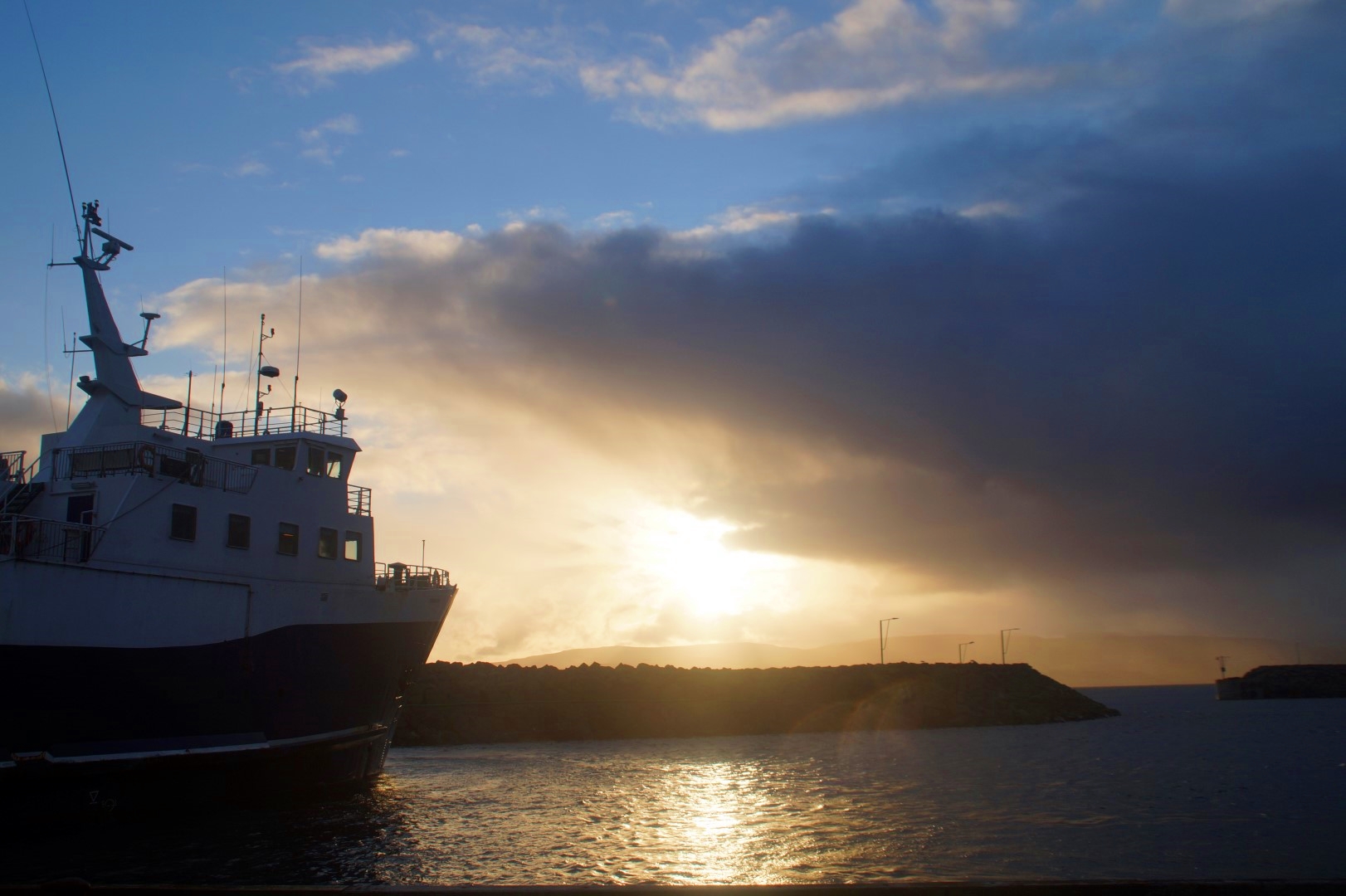
Getting around on Nólsoy
Nólsoy is a small island with only one village and a limited amount of roads, so while you can bring a car on the ferry, I advise you not to. Nólsoy is better explored on foot, and everything is reachable on a day trip.
There is no public transportation on the island.
Good to know on Nólsoy
Tourist information
Not sure what to do on Nólsoy? Head to Visit Nólsoy’s office for a chat and some good tips about the island at 11 í Túni (the small yellow building at the marina in the middle of the village).
The office is open from May 1st to September 1st from 10 AM to 5 PM. Contact Visit Nólsoy at anja@visitnolsoy.fo or +298 527060 or visit their website.
Public toilets
There are public toilets near the supermarket which you can use free of charge (open 24hrs), and there are also public toilets at the harbour which are also free and open during ferry operating hours. Both are available for the disabled.
You can get fresh drinking water at both public toilets.
Shower
The public toilet near the supermarket also has a shower with hot water that can be used free of charge. It is always open, so you can just go whenever you need it!
Shared wheelbarrows
Got something heavy to carry? Feel free to borrow a wheelbarrow at the harbour or at the grocery store to carry your luggage or shopping bags to your accommodation. But do remember to put them back after use!
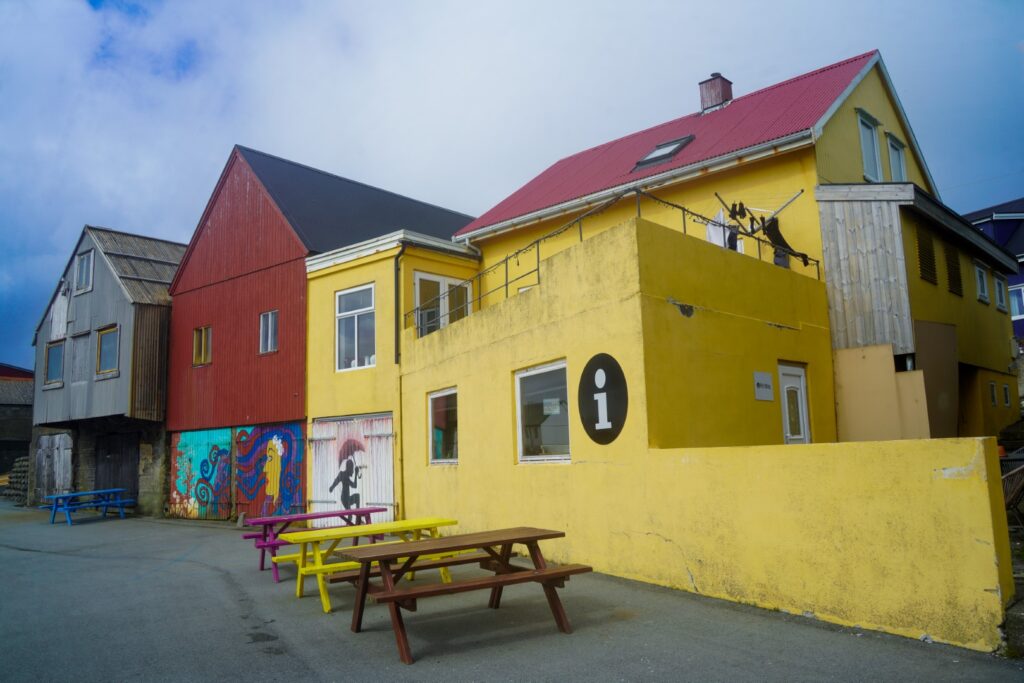

Accommodation on Nolsoy
Most people go to Nólsoy on a day trip, but if you feel like staying for a couple of nights, there are plenty of options for you. Nólsoy has the right size for a day trip where you can see a lot, but to really get a feel of the island, I recommend staying for at least a few days.
Camping
There’s a free primitive tentsite just above the harbour (when you get off the ferry, go right up the hill, then turn left and walk a few hundred metres and the campsite is to your right). The terrain is quite uneven but there are a few flat spots to pitch small tents. It’s also possible to park a caravan or motorhome overnight in front of the football field for 100 DKK per night. Electric power can be provided on request.
For toilets and shower, see the information above.
Contact Visit Nólsoy for more information at +298 52 70 60 or info(at)visitnolsoy.fo.
Airbnb
As of May 2023, there are two Airbnb options on Nólsoy. See here and here.
Hjá Margreth og Terja
Enjoy an atmospheric stay above Maggie’s Café in a flat with four bedrooms, a living room, kitchen, bathroom and toilet.
A single bedroom costs 400 DKK per night. A double bedroom costs 600 DKK for one night, 1000 DKK for two nights and 1500 DKK for three nights. If you want to rent the whole flat, the price is 1500 DKK per night. Prices include bed linen, towels, water, electricity and WiFi. The flat is available for rent between May and August. Read more here!
The house at Pálsgøta 10
If you’re travelling with a small group of up to eight people, you can rent this three-bedroom house in the centre of the village.
The price per night for eight people is 1000 DKK, and there is a cleaning fee of 500 DKK. Furthermore, bed linen and towels cost an additional 100 DKK per person. To book the house, contact anja(at)visitnolsoy.fo or +298 527060.
The holiday cottage
A small group of up to ten people can also choose to stay at ‘the holiday cottage’ in the village centre, which has three bedrooms, a living room, a kitchen and a bathroom.
The price per night is 900 DKK including towels and bed linen. To book the house, contact vgulklett(at)hotmail.com or +298 517810.
Royndarhúsið, the village hall
If you’re travelling with a large group, it might be reasonable to rent the village hall which can fit around 30 people on mattresses – and even more, if you bring your own!
The house has a well-equipped kitchen, a dining room with space for about 100 people, two toilets, a bathroom and a room with a stage. Contact +298 589590 or royndarhusid(at)gmail.com for more information!


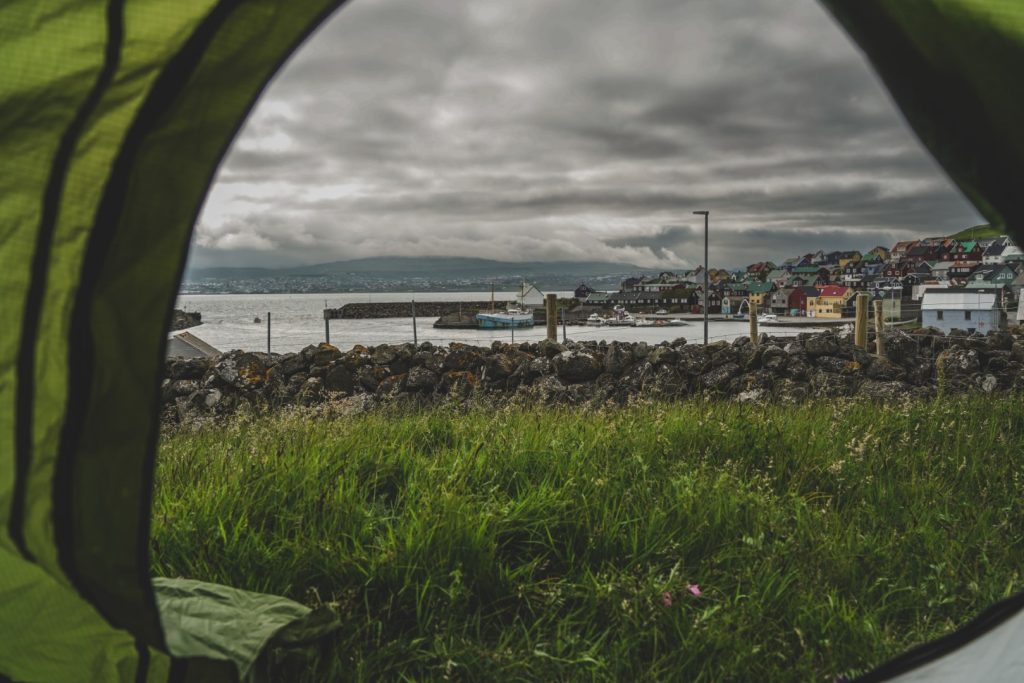
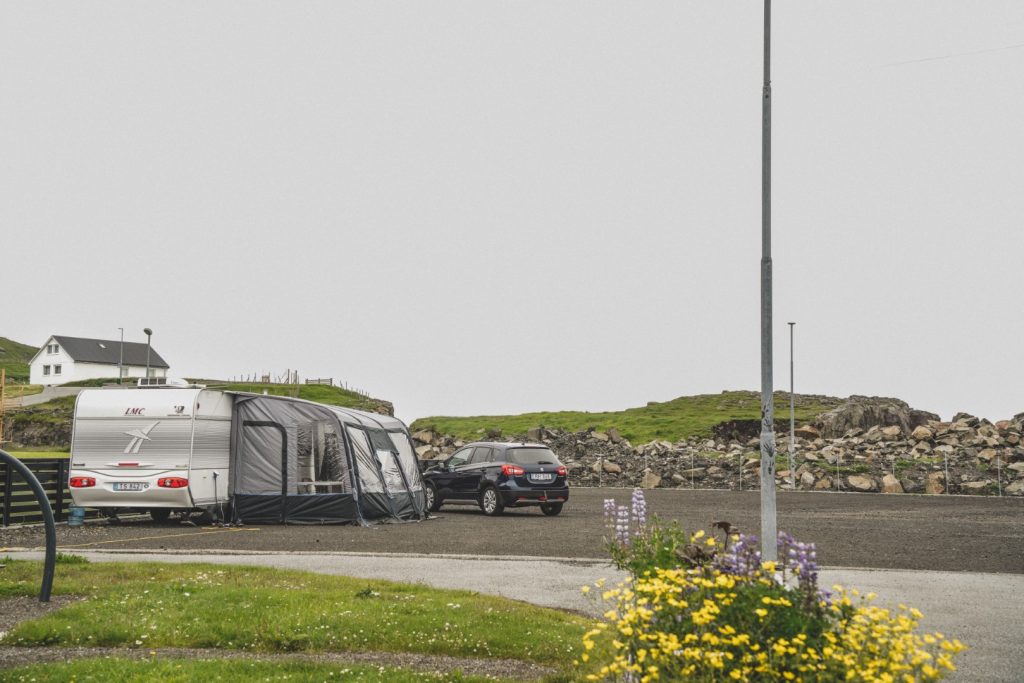
Dining and shopping on Nólsoy
Despite its small size, Nólsoy has two cafés and a grocery store, so you won’t go hungry there. However, for vegans and vegetarians there are not many options, so I recommend bringing some food from Tórshavn if you plan to stay overnight.
Maggie’s Café
The local bar and one of the most popular music venues in the country. This café is a must-visit if you’re on Nólsoy during the evening as the atmosphere is always cozy, and they often have live music. They serve classic bar food such as burgers and fries, pitas, fish and chips, and beer, cocktails, sodas and coffee.
Maggie’s Café is open Monday to Thursday from 1 PM to 7 PM, Friday and Saturday from 1 PM to 11 PM (kitchen is open until 8 PM) and Sunday from 1 PM to 8 PM. However, from September till May, they are only open Thursday till Sunday. Read more on their website.
Neystkafé
Relax at this cozy and atmospheric café by the harbour where you can enjoy a nice meal and a hot drink.
The café is located in the same building as Visit Nólsoy. Read more here.
Heimavirkið, a handicraft shop
Shop local goods made by Faroese with a connection to Nólsoy at Heimavirkið. The goods can change from week to week but you’ll be able to find traditional Faroese clothing such as woollen socks and sweaters.
The shop is open Mondays-Fridays at 2 PM to 5 PM and Saturdays at 11 AM to 2 PM from June 1st to August 31st. Outside opening hours, it might still be possible to visit if you request it on +298 217002. You can also take a look at their Facebook page to see some of the stuff they’re currently selling.
Heimablíðni, dinner with a local
Enjoy a homemade dinner in a typical Faroese home with locals Maud Wang Hansen and her husband. You can order a three course menu with local seasonal food.
Contact Maud on her facebook page, at +298 288606 or at maudwanghansen(at)gmail.com.
Matvørubúðin, the local grocery store
The local grocery store, where you can get the most basic foods, snacks and souvenirs.
During the summer time, the supermarket is open Monday to Friday from 9.30 AM to 5.30 PM and on Saturdays from 10 AM to 1 PM. They are closed on Sundays. In the winter time, the opening hours may differ. Contact + 298 327150 for more information.
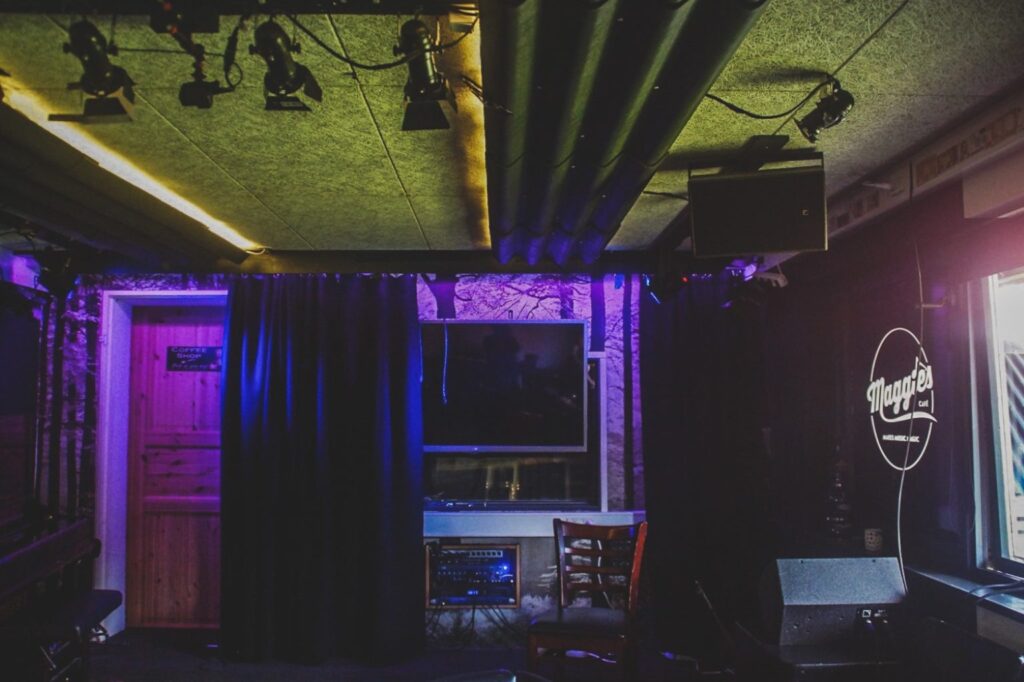

What to see and do in the village of Nólsoy
The whale jawbones
The first thing you’ll see when you get to Nólsoy is the “Gate of Honour”, made from giant blue whale jawbones! The whale was reported to be 25 metres long, caught by the people of Nólsoy in 1895. While the jawbones were reserved for the gate which was erected in 1907 for the visit of King Frederic VII of Denmark, parts of the backbones were and still are used as stools in homes on Nólsoy. The gate was taken down shortly after, but in 1975, it was erected once again where it currently stands.
Murals by the marina
Take a stroll along the harbour and study the many colourful and creative murals. There are also several murals to be found along Kongsstovubrekka in the village.
Brunn Museum
This local folk museum belongs to the Nólsoy heritage association, Fornminnisfelagið. It showcases a typical Faroese house in the late 20th century. Ten generations of the same family lived in this house for over 300 years. The last resident moved out around 1960, and in 1985 the house was given protection status and turned into a museum.
The museum does not have set opening times, but you can ask at Visit Nólsoy and they will help you out. Contact them at +298 52 70 60 or info(at)visitnolsoy.fo, or visit them at their office. Entrance price is 60 DKK. Click here to read more about the museum.
Jens Kjeld’s taxidermy museum
Knock on Jens Kjeld’s door and see if he’s home, so you can visit his small museum of stuffed and dried animals, including the largest private collection of lice in the world. Jens Kjeld is a specialist when it comes to birds and insects, and he’s happy to share his enormous amount of knowledge with visitors!
Entrance price is 30 DKK (only cash). There’s also a small shop with creative souvenirs, so remember some extra cash! Read more on his website.
The boat Diana Victoria
The boat that Ove Joensen rowed from Nólsoy to Copenhagen in 1986 is exhibited in the basement of Visit Nólsoy. Ask the staff and they will open it for you.
The village church
Attend a Sunday service or explore the church from 1863 on your own.
Contact nolsoyar@kirkja.fo for the opening hours.
The Nólsoyar Páll monument
West of the church stands a monument in memory of Nólsoyar Páll, the national hero of the Faroe Islands. He was a sailor, boat builder, inventor, poet and farmer, born in 1766 on Nólsoy.
Along with two friends and two of his brothers, he built the first Faroese deck vessel with the wood from an English shipwreck, with the purpose of developing the fishing industry in the country. He disappeared during the 1807 war between Denmark and England, and has since been hailed for his role in the development of the Faroese economy, and for his poetry of which Fuglakvæðið is his most renowned work.
Laze by the beach
The tiny sandy beach in the village is called Malarendi, and it’s the perfect place to soak up the sun if you’re lucky enough to get any. On a warm day, this place will be swarming with locals so it’s also a great place to meet new people.
Spot the llama
Yeah, there’s a pet llama on Nólsoy! Go find this unlikely pet in the village – his location changes, but his neck is usually easy to spot!
Mini golf
The grocery store rents out golf clubs for the mini golf course located right behind the store.
Concert at Maggie’s
An intimate concert with local bands is always a great experience.
See the list of concerts and how to book here.
Learn to spin wool
Visit Vevstovan and watch Guðrun spin and weave local wool.
She also gives occasional workshops where you can learn to spin threads from local sheep wool on a traditional spinning wheel. Workshops last one or three hours, and cost 200 DKK or 450 DKK per person. Contact Guðrun at +298 527002 or on her facebook page for more information.
Ovastevna
Ove Festival is held annually in the summer on Nólsoy, in honour of Ove Joensen, who rowed from Nólsoy to Denmark in 1986.
Keep an eye on this website for the dates.


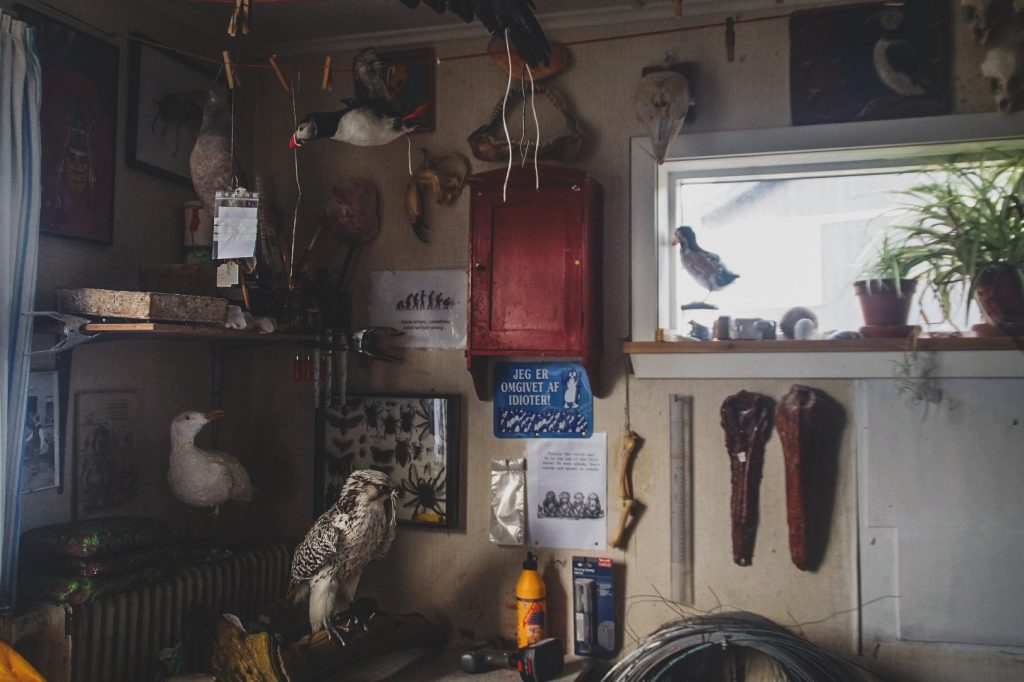
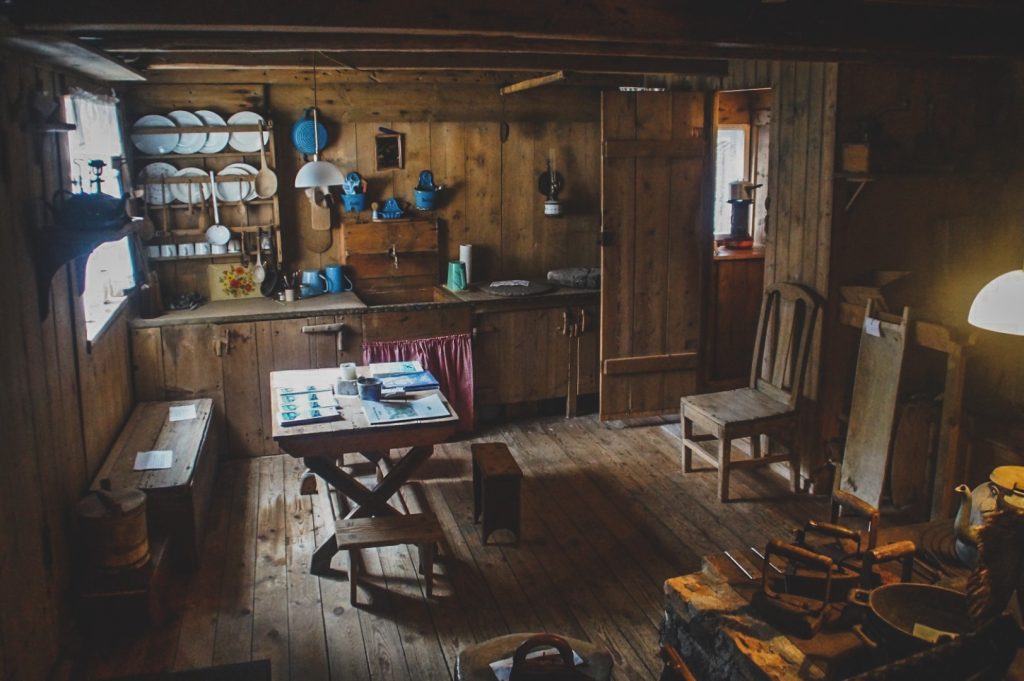
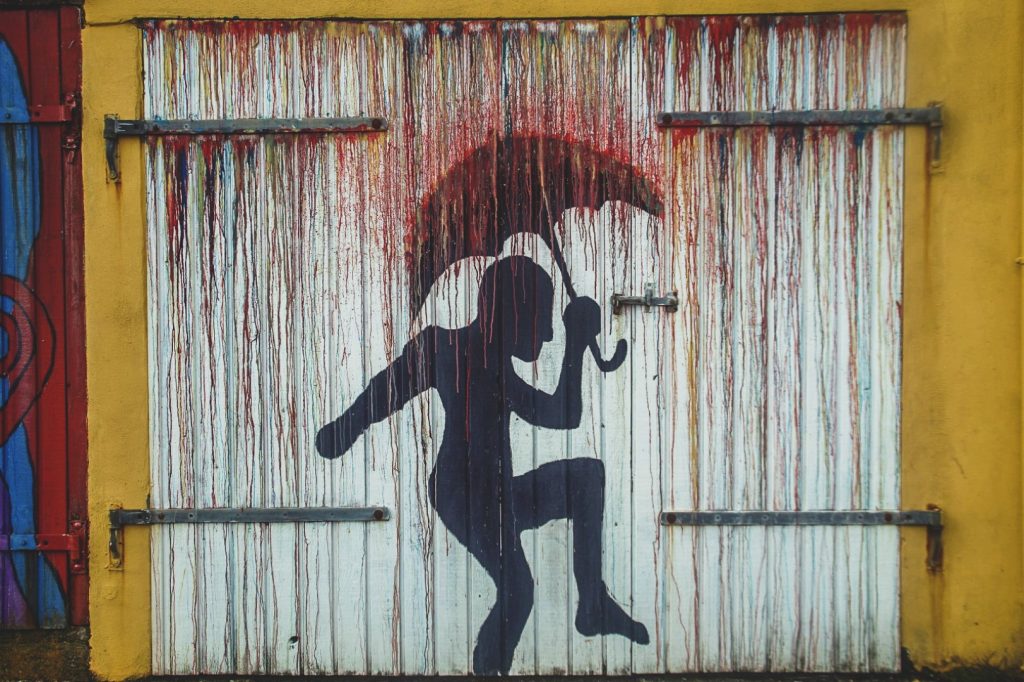
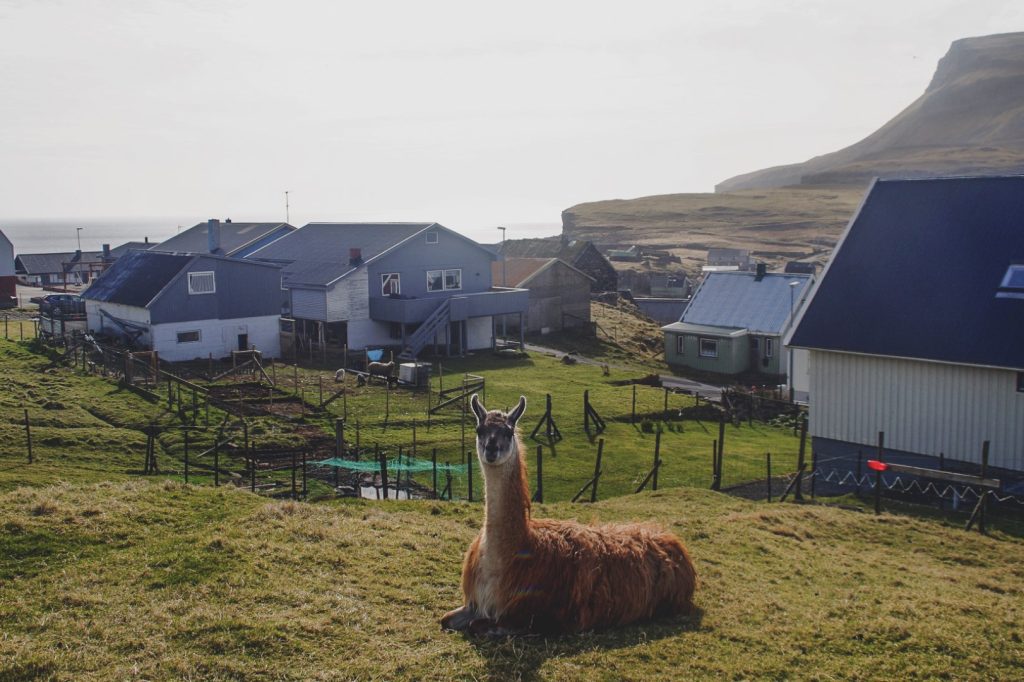
Abandoned places on Nólsoy
The old outhouses of Eiðið
On the small hill of Eiðið above the harbour are the remains of stone-built outhouses, traditionally used for drying fish and meat from whales and later as haybarns. Most of the outhouses are no longer in use as the rough ocean is slowly but surely eating away at the rocky hill, but it’s still possible to walk among them.
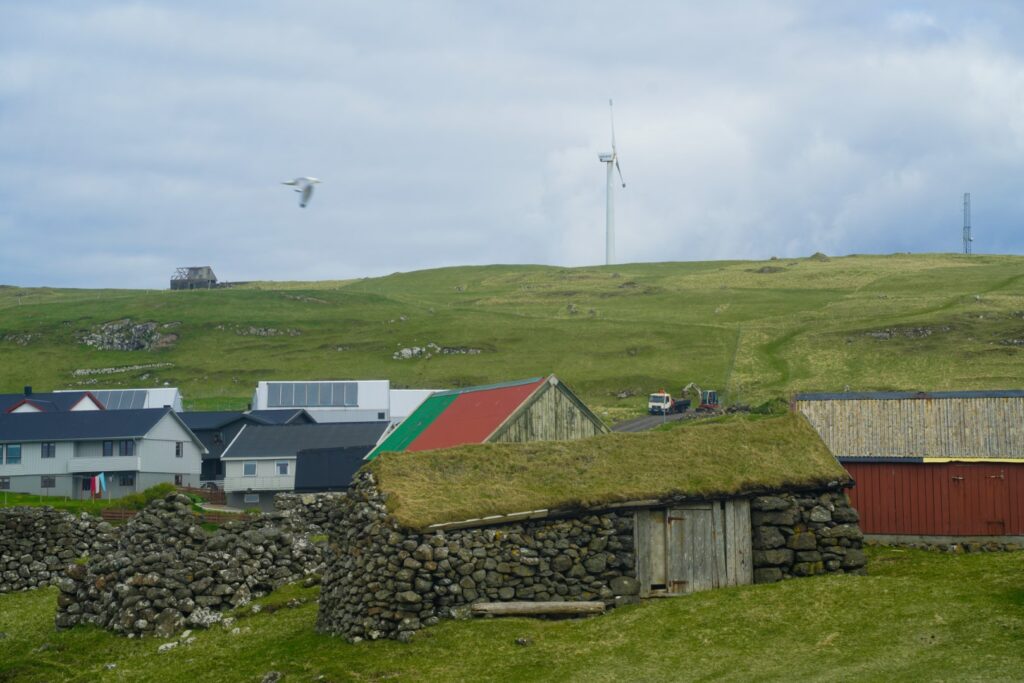
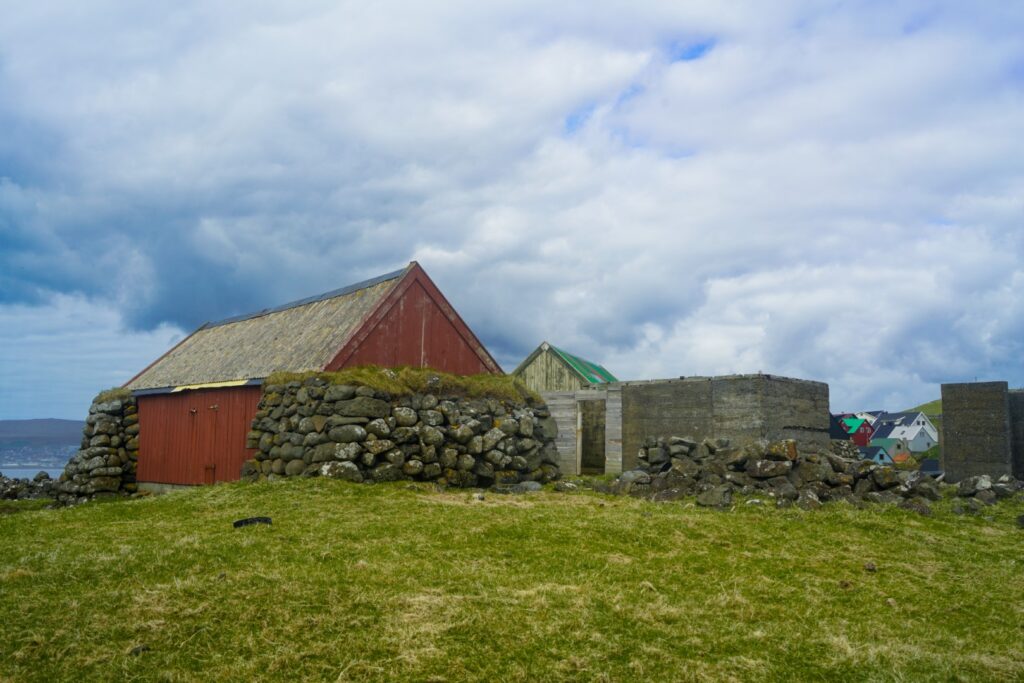
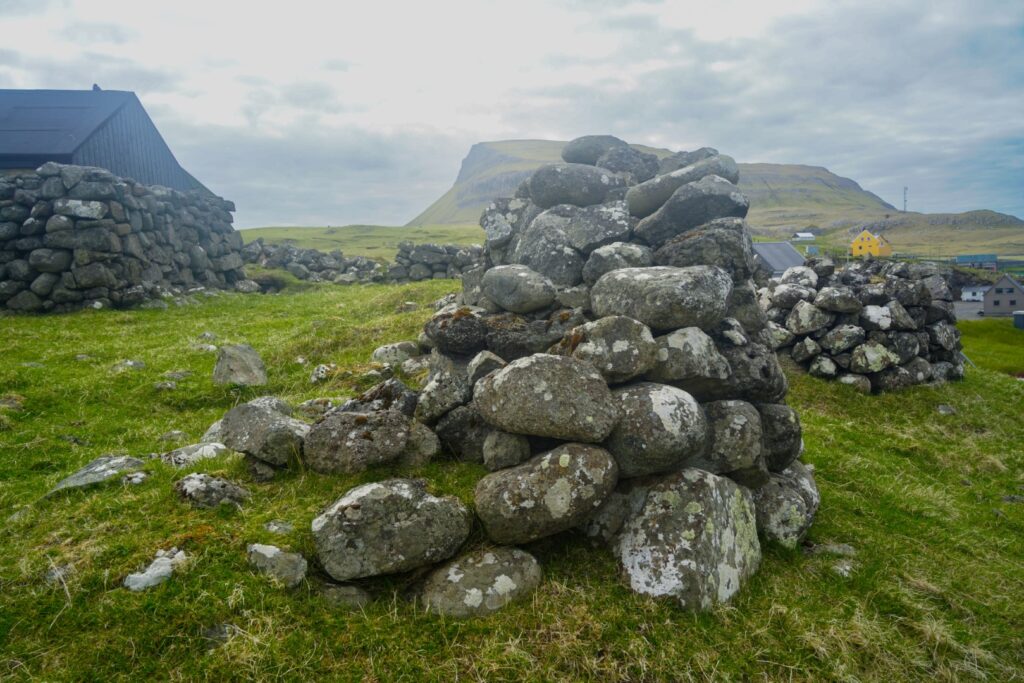
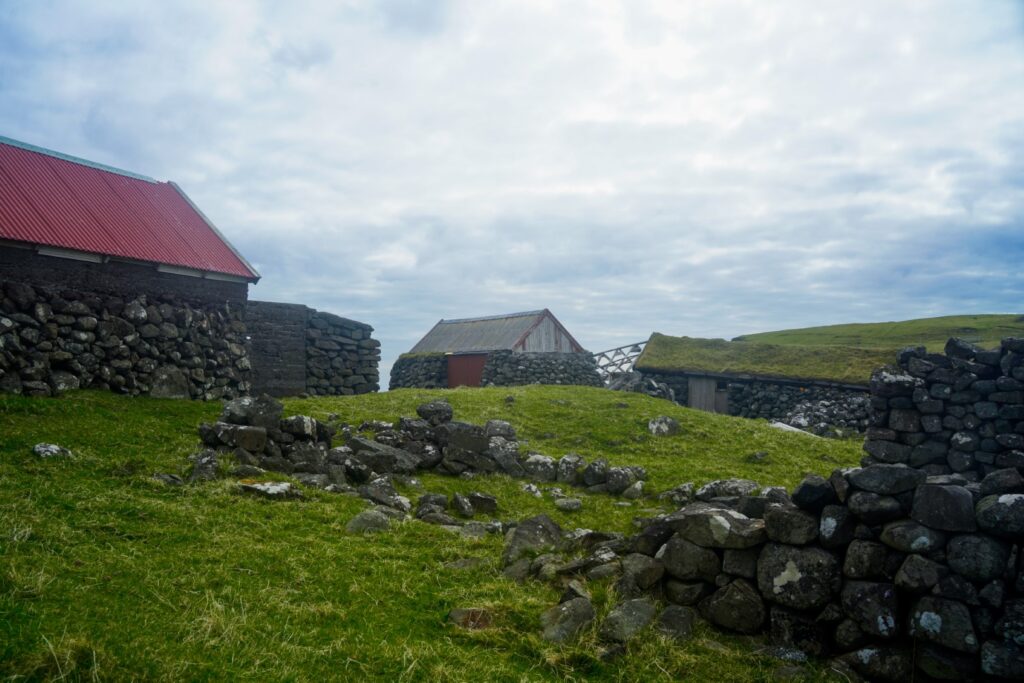
The abandoned village of Korndalur
A few hundred meters southwest of the village lies the remains of Korndalur, the first settlement on Nólsoy. Korndalur was inhabited from the 14th century until the mid-18th century. The settlement is one of the best preserved medieval villages in the country. A runic stone was discovered in 1920 when a gravel road was being built right through the ruins, but unfortunately, the runic stone has since disappeared.
According to a local legend, a Scottish princess, daughter of a King James of Scotland, fled from Scotland to marry the man she loved, whom her father disapproved of. They settled in Korndalur at a time when the island was abandoned after a plague pandemic, and soon had a son. One version of the legend says that King James discovered the whereabouts of his daughter and came to kill her and her husband but changed his mind when he saw his grandson. An alternative version says that the princess spotted the king’s fleet arriving, told her husband to hide and took the child to the shore to meet her father. She told him that he would have to kill her and the child before being able to kill her husband. But the little boy charmed his grandfather, and the King instead invited his daughter and her husband to live in Scotland. They refused the offer and instead lived the rest of their lives on Nólsoy. Some locals claim to be descendants of them. One of the ruins in Korndalur is named “The Princess Ruin” after her.

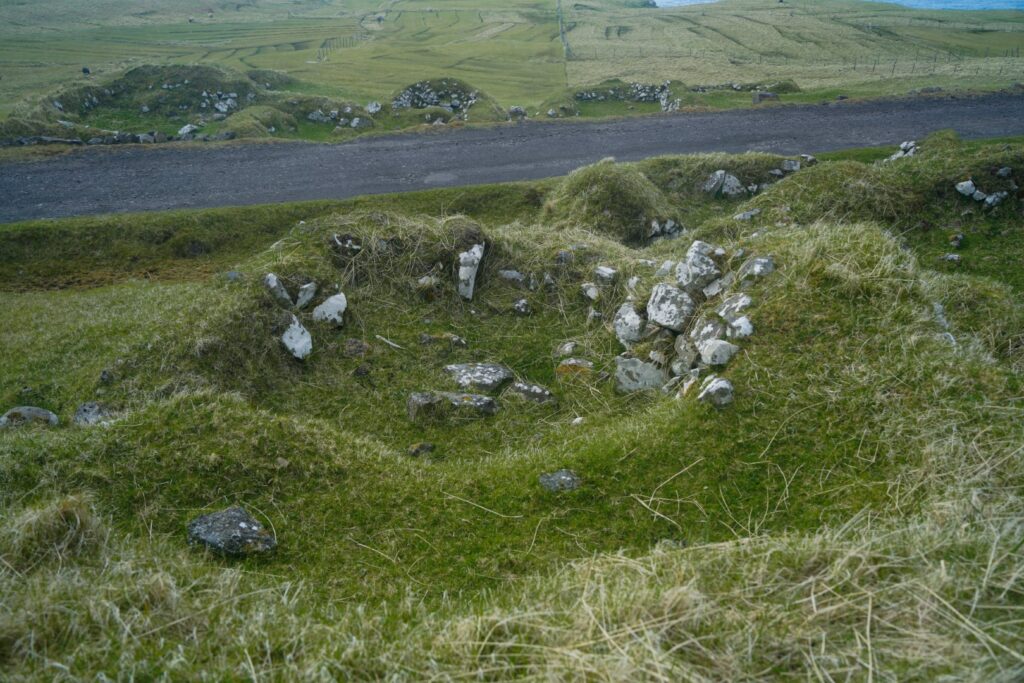
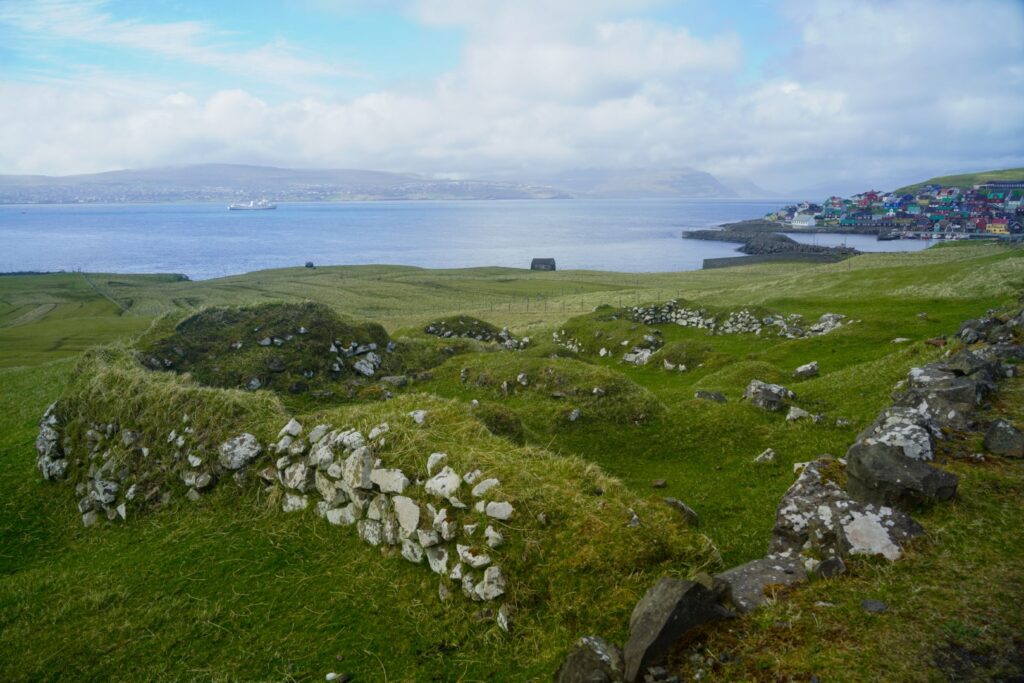
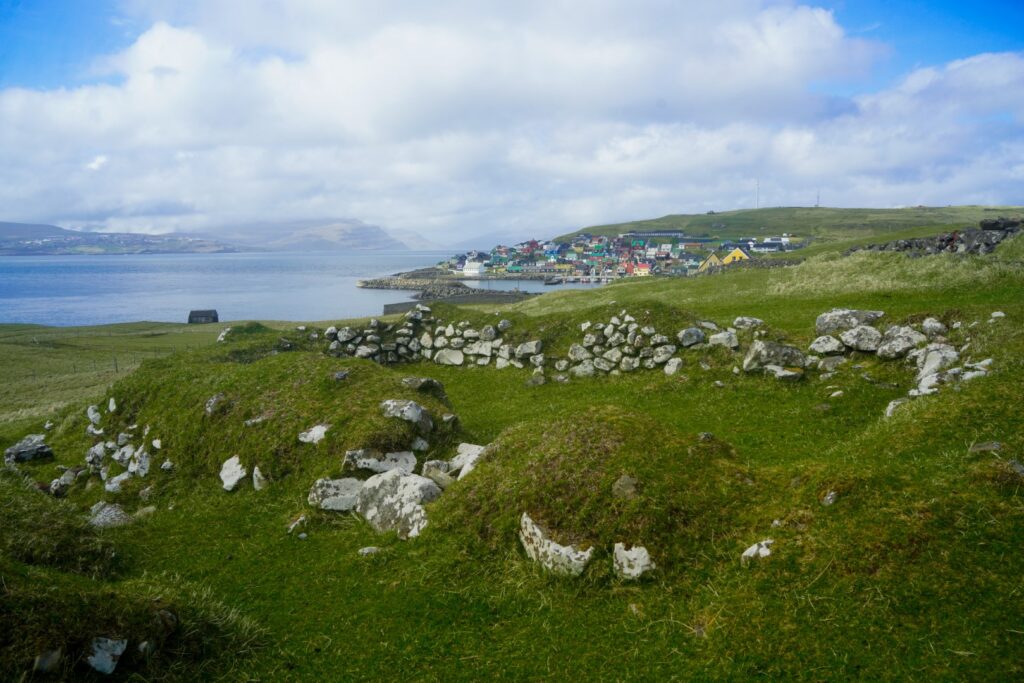
Korndalur’s outhouses
On a hill just southeast of Korndalur stands the ruins of seven outhouses that were once used by Korndalur’s inhabitants. They can be a bit difficult to locate as they’re quite spread out, but all seven are still clearly visible in the landscape.

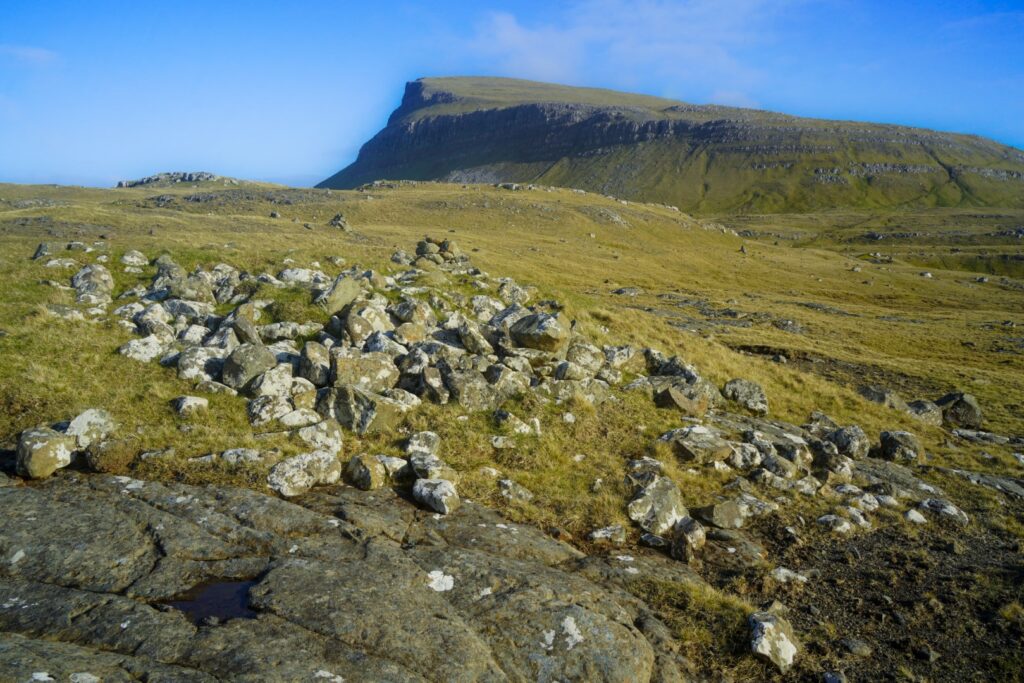
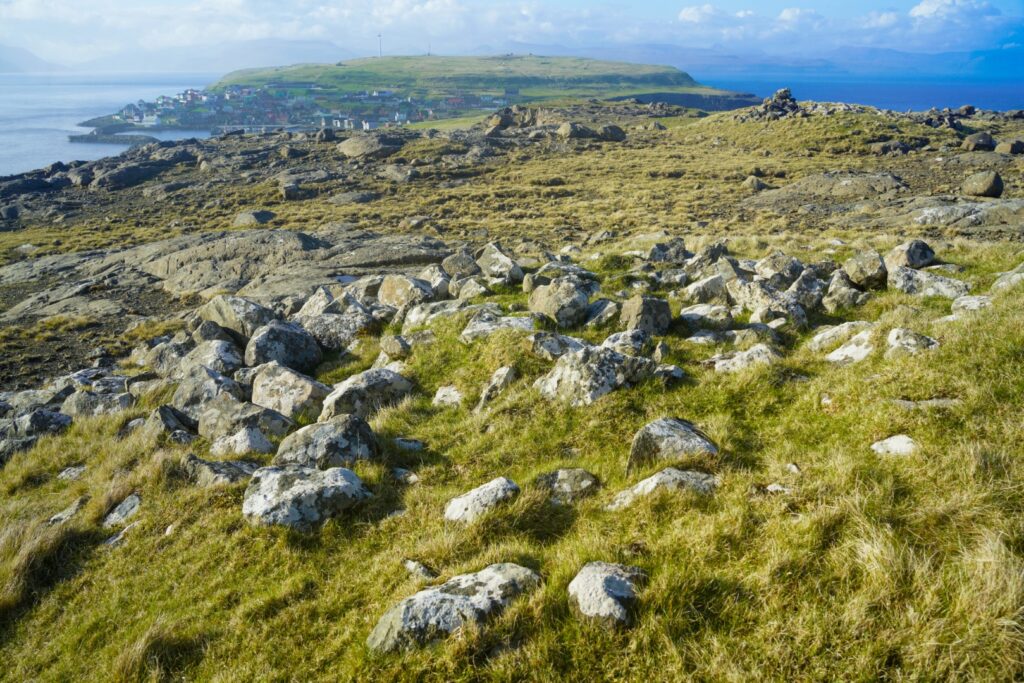
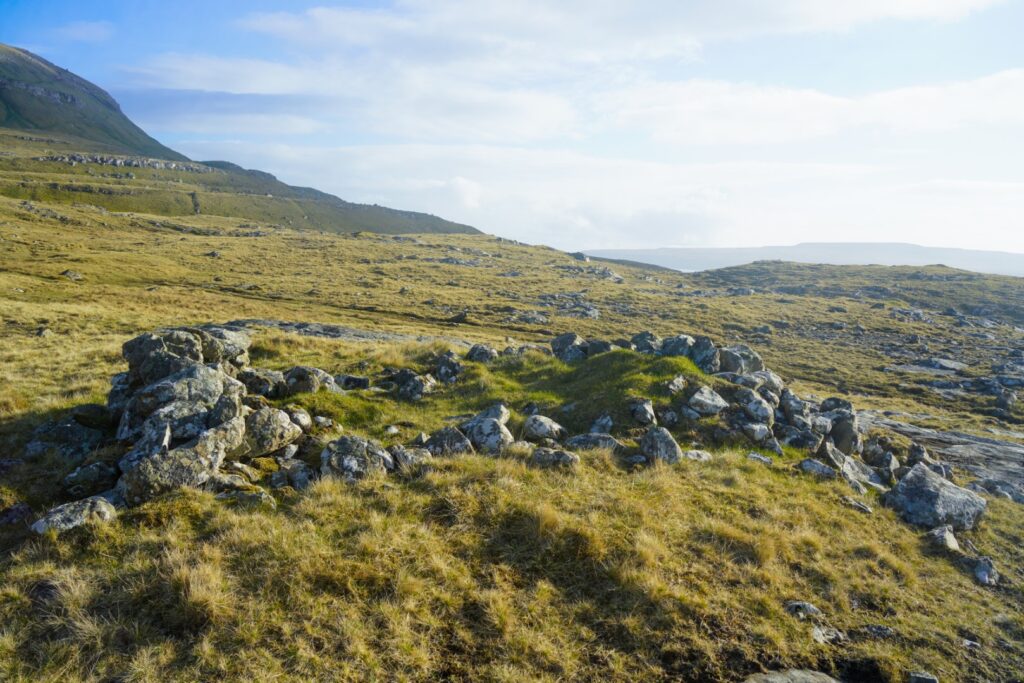
The water mills at Myllá and Storá
Between Korndalur and its outhouses lie the ruins of two water mills, seemingly used by the villagers. The upper mill is easily found by taking the trail on your left when coming from Korndalur. The lower mill is ca. fifty metres below it, directly over the Myllá stream.
If you continue along the west coast to just north of Tjørnunes, you’ll find the ruin of a mill at the Storá stream. The design of the mill is very similar to those at Myllá, so I would guess that they were built around the same time.
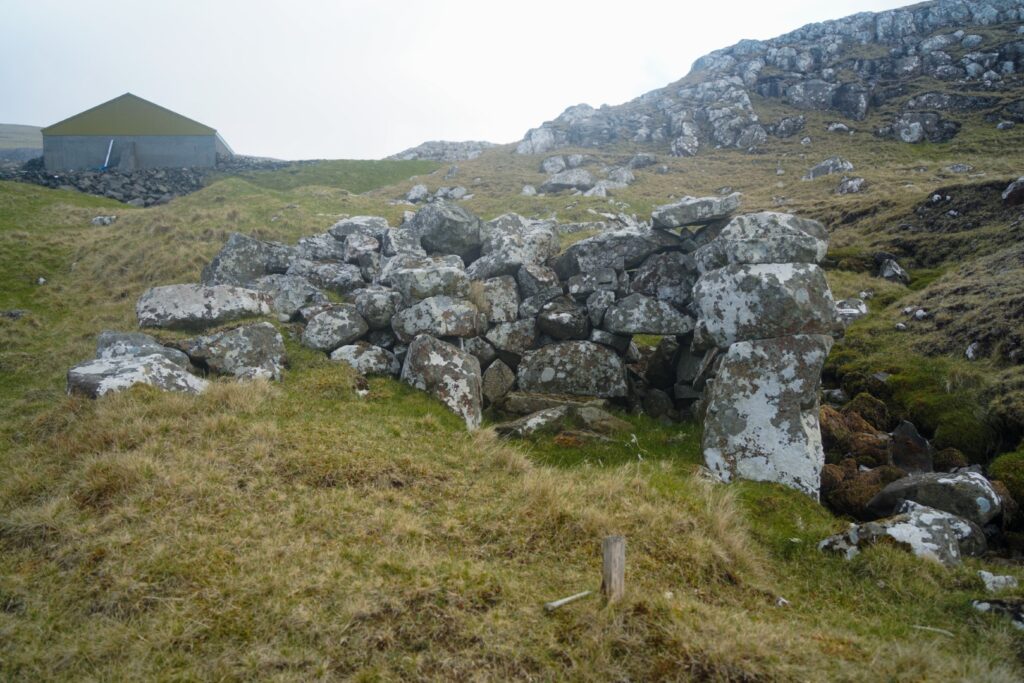
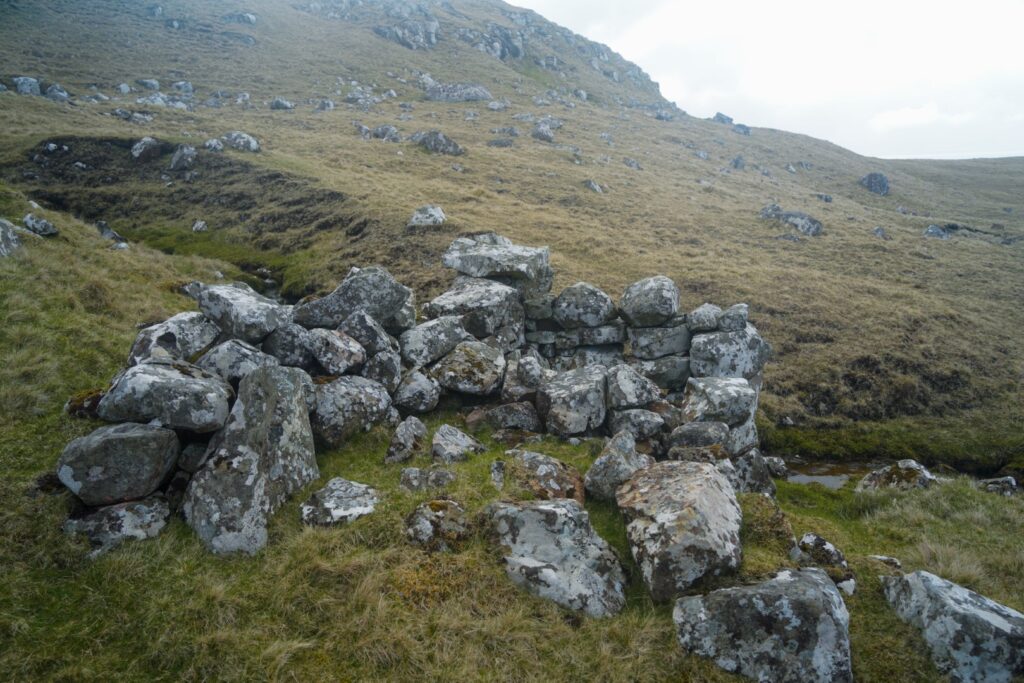
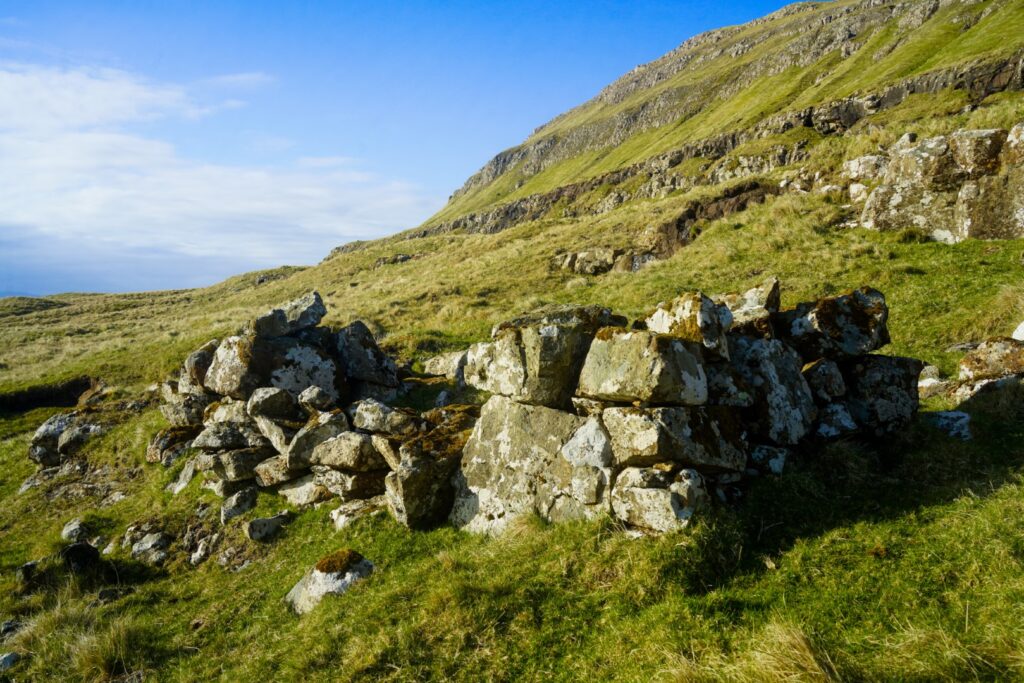
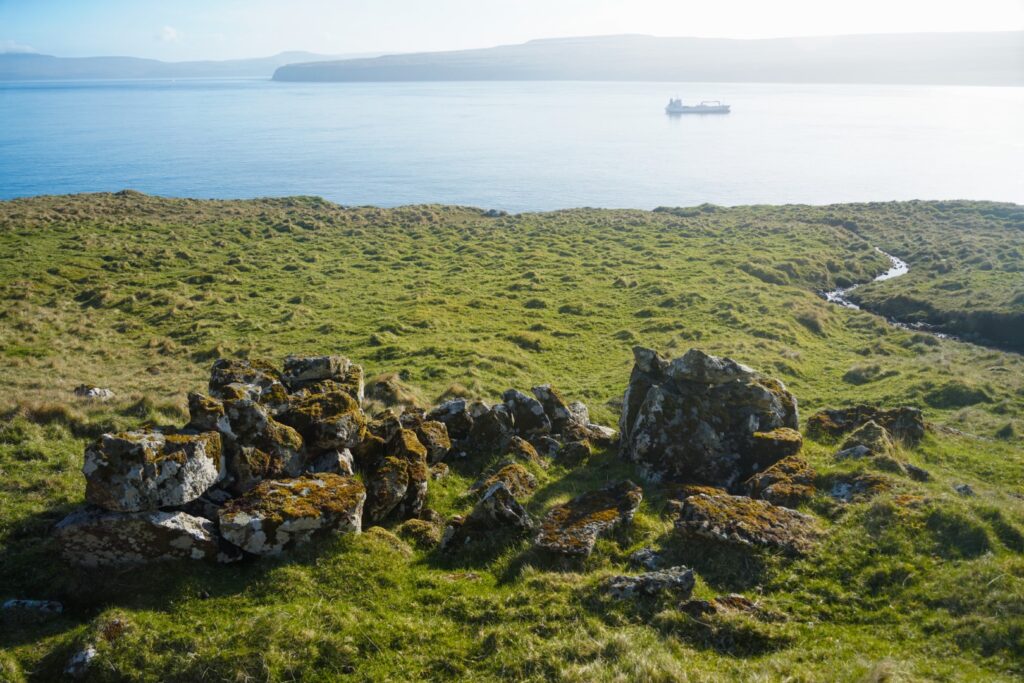
The abandoned village of Í Kassunum
Approximately 100 metres above Leirgjógv on the west coast lies the ruins of the ancient settlement of Í Kassunum. It’s unknown exactly how old this settlement is and when it was abandoned, but it is thought to have been one of the earliest short-lived settlements in the country, so think Viking Age!
The ruins can be quite difficult to locate and I’m not sure exactly how many there are. I counted four, but it is definitely possible that there are more hiding in the grass!
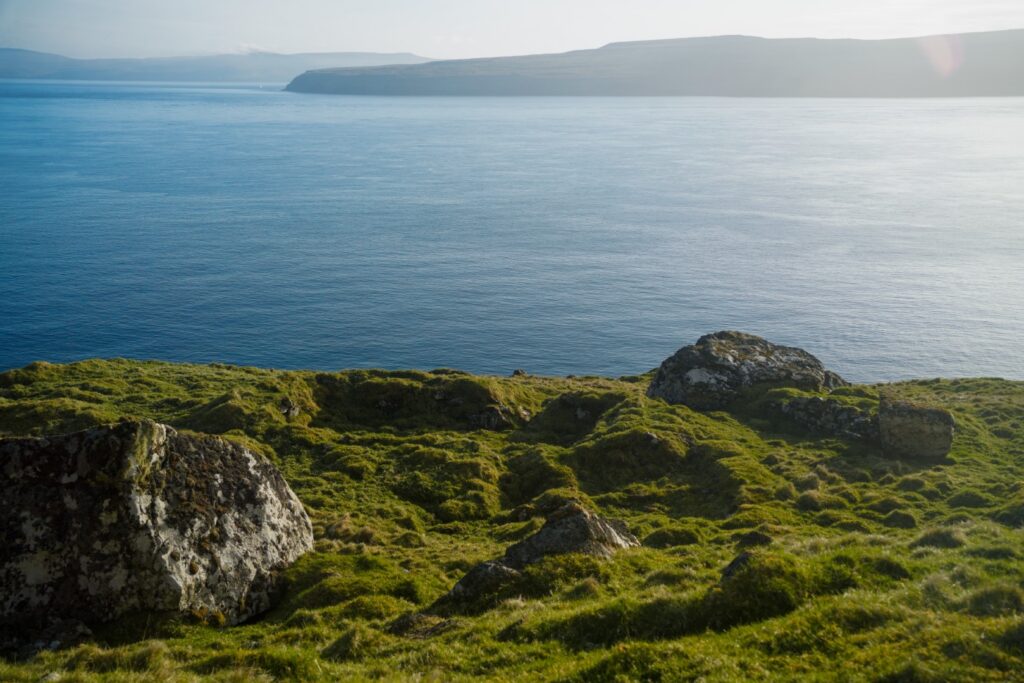
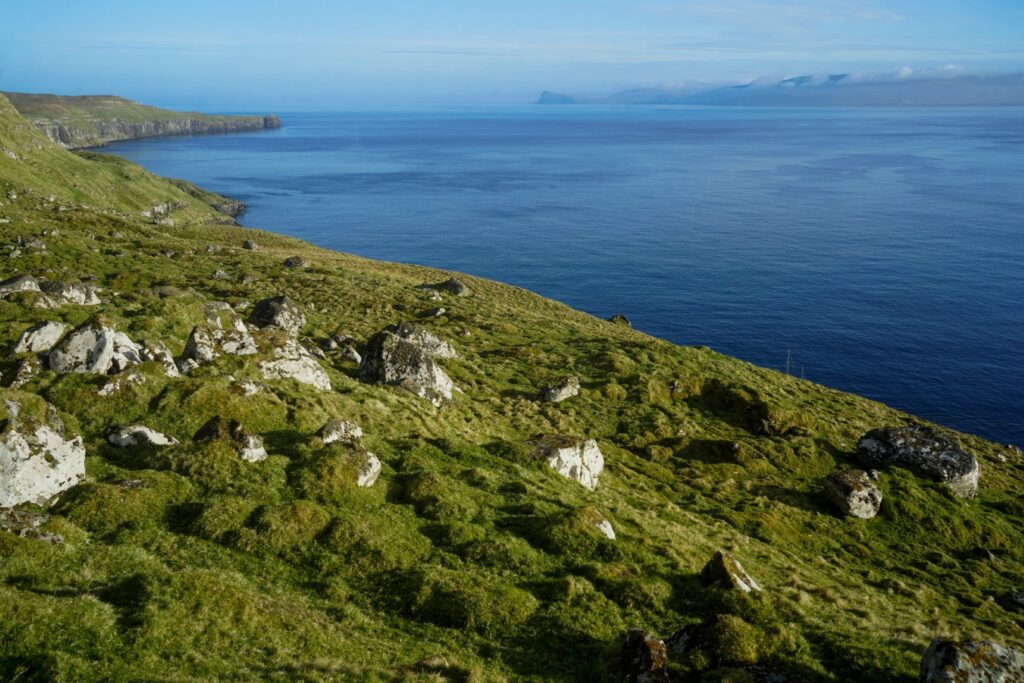
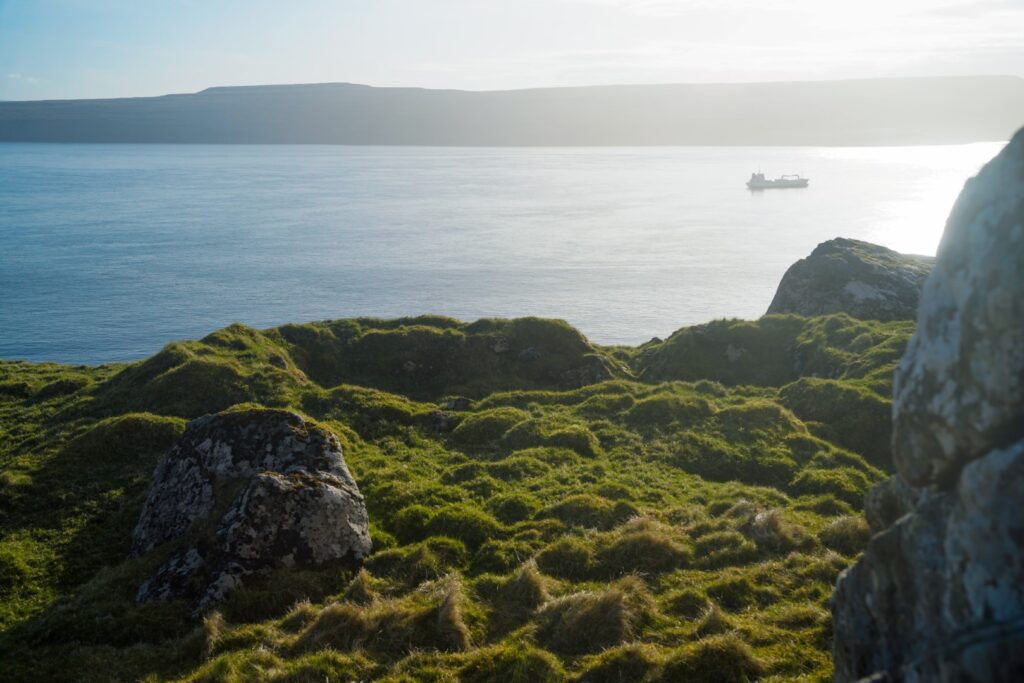
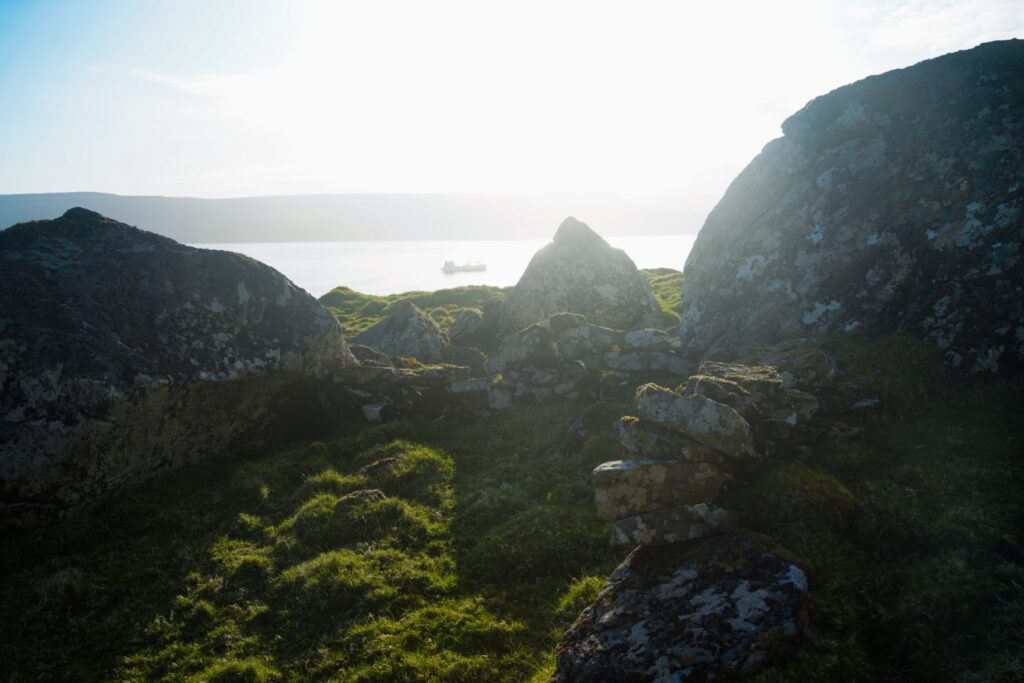
The dockyard at Stallurin
At the far southern end of Nólsoy, between the two lighthouses, sits the small dockyard of Stallurin. Once used as a landing place for boats with goods to be unloaded for the families living at Nólsoyarviti or for shipping peat, this docking place is now only in occasional use by private sailors.
The name ‘Stallurin’ means ‘the stall’ and stems from the boats being able to lie side by side like horses in a stable.
It’s possible to walk down to Stallurin from the trail between the lighthouses. Read more below!
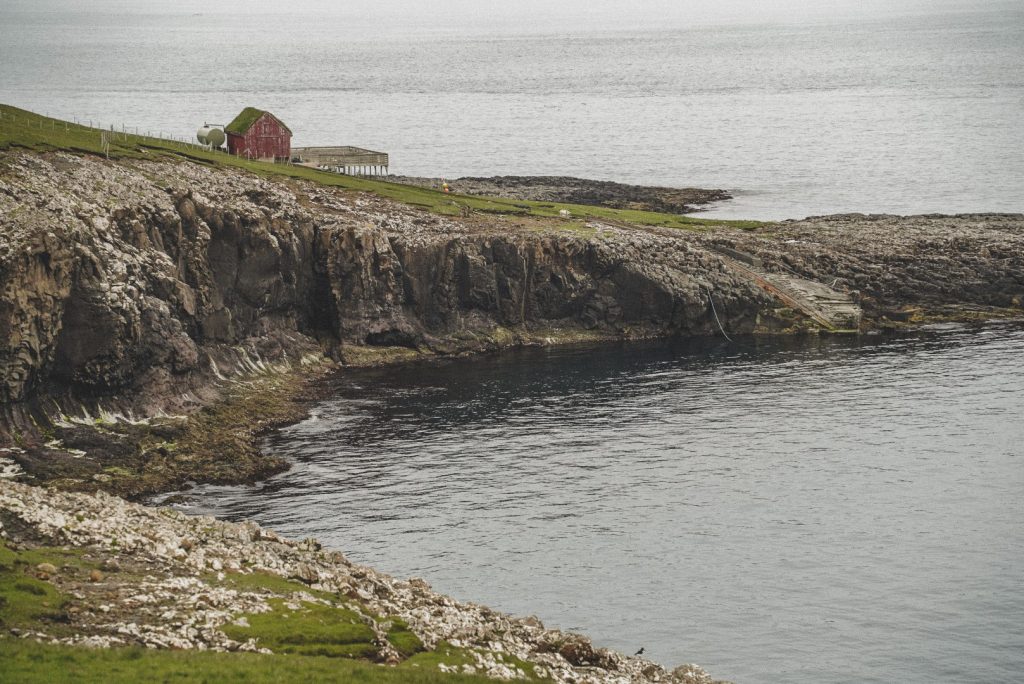
Lighthouses on Nólsoy
Nólsoy Lighthouse
Known as ‘the lighthouse at the end of the world’, the lighthouse at Nólsoyarviti on Nólsoy’s southeastern point is by far the best known of Nólsoy’s two existing lighthouses. It’s the oldest of the two (but only by seven years), built between 1892 and 1893 of carved basalt and granite rocks from the island, placed on a cliff 62 metres above sea level. The adjacent buildings were built by the British during the Second World War to mislead the Germans. They were since used as homes for three families, and when the population at Nólsoyarviti was at its peak, there were ten children, so Borðan alternated with the Nólsoy village in having school classes. In later years, the houses were used by the lighthouse keeper, but today, the lighthouse is automated and the adjacent buildings no longer in use.
During the Second World War, all lighthouses on the Faroe Islands were blacked out, and the facilities on Nólsoy were severely damaged in an air raid in 1941. Reparation began in 1948, and today, the lighthouse stands tall at 14 metres with one of the largest lenses in the world and the brightest beacon in the entire North Atlantic.
A 12-kilometre hike to the lighthouse and back is the most popular hiking trail on Nólsoy. Read more below!
Borðan Lighthouse
Ca. 1,5 kilometre west of Nólsoy Lighthouse stands its lesser known cousin, Borðan Lighthouse. It was built in 1900 on the southernmost end of the island. Unfortunately, I wasn’t able to find any information on this lighthouse, but I do wonder why building another lighthouse so close to Nólsoy Lighthouse was necessary.
This lighthouse is easily reached by extending the hike from Nólsoy Lighthouse with three kilometres (1,5 km each way). On the way, you’ll pass by the small dockyard at Stallurin. Read more below!
Flaggstongin
On the northern tip of Nólsoy sits the remains of the islands’ first lighthouse, built in 1849, 74 metres above the ocean. The circular stone masonry that can be seen today was the base of the lighthouse, holding up a mast with a barrel on top. A simple construction that can be quite hard to imagine in use as a lighthouse!
Flaggstongin is easily reached from the village on a short hike to Stongin. See more below!

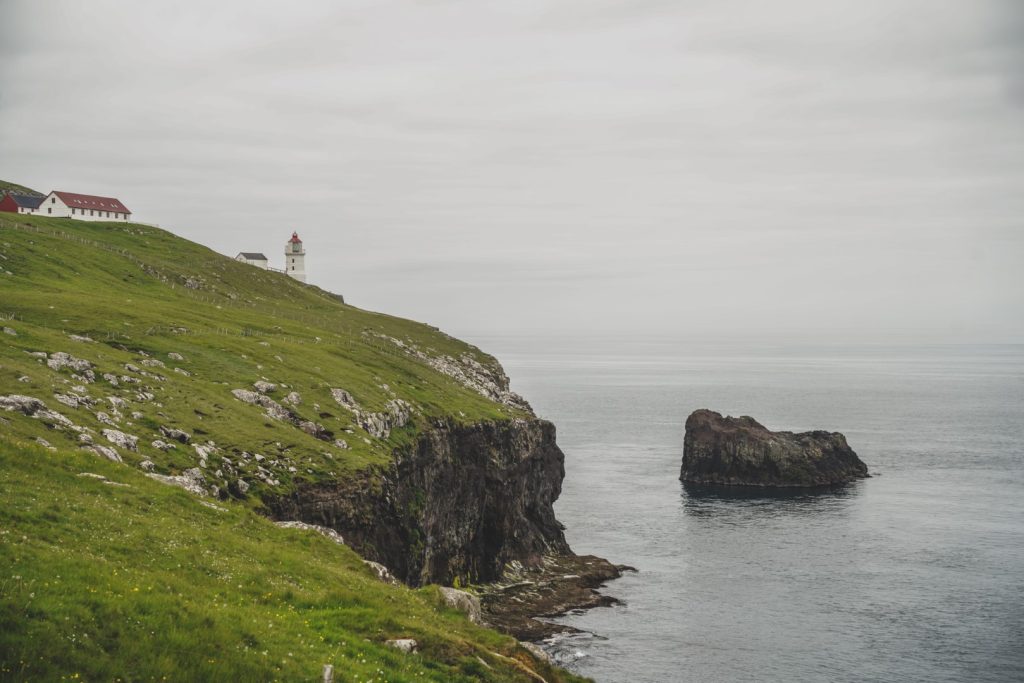
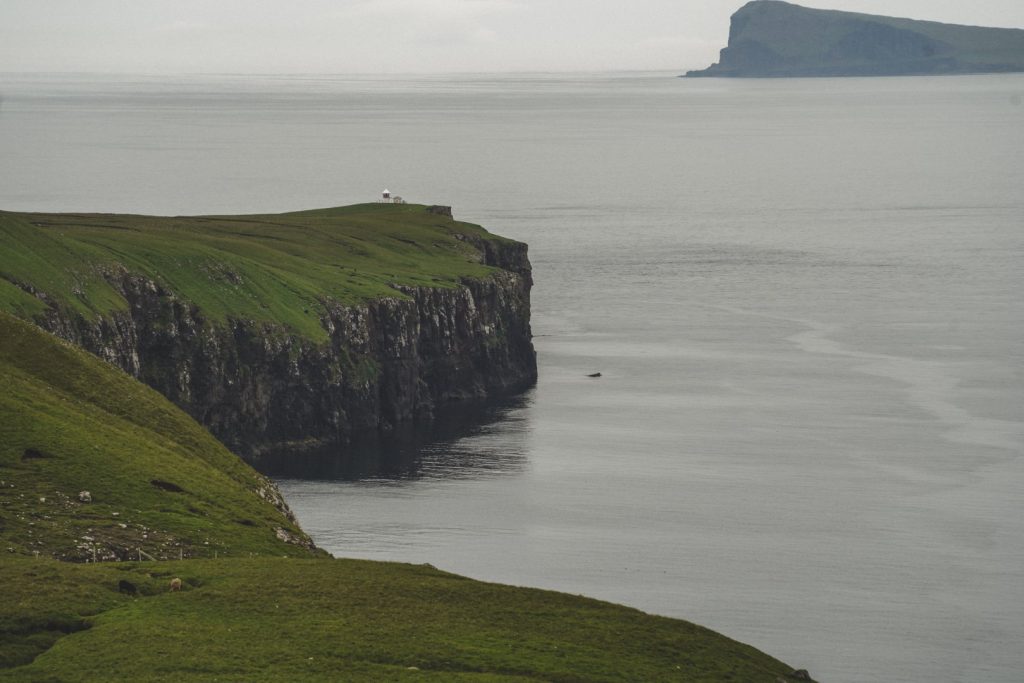
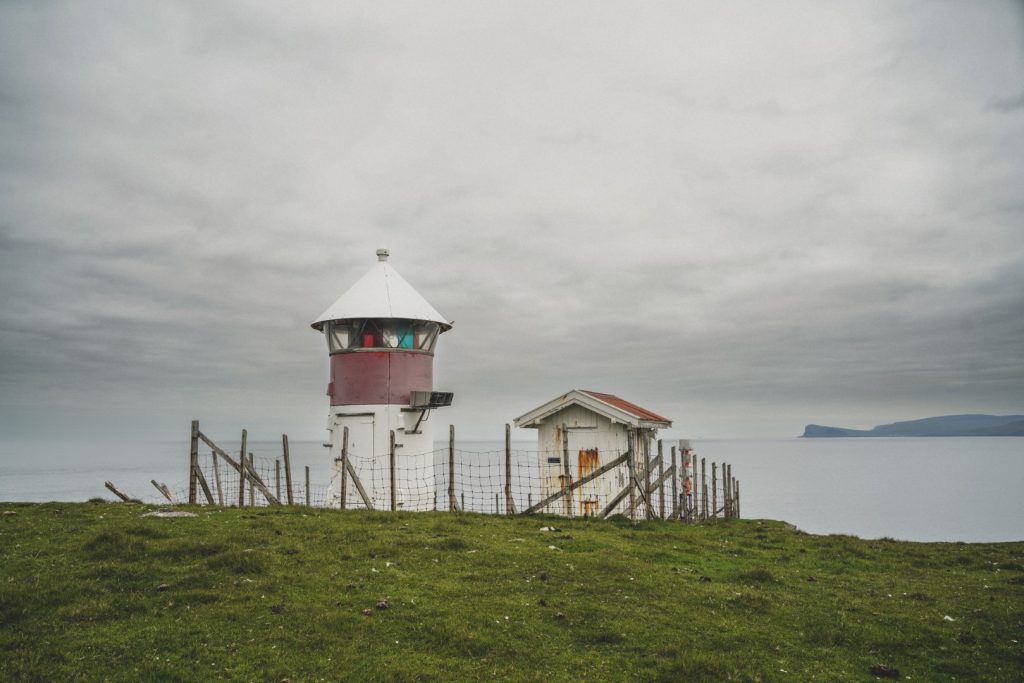
Mountains on Nólsoy
There are four official peaks on Nólsoy, all of which are south of the village:
- Eggjarklettur = 372 m.
- Uppi á Manni = 352 m.
- Skúvafjall = 234 m.
- Líðarfjall = 152 m.
All four mountains are easily climbed in one day hike. See the route description below!

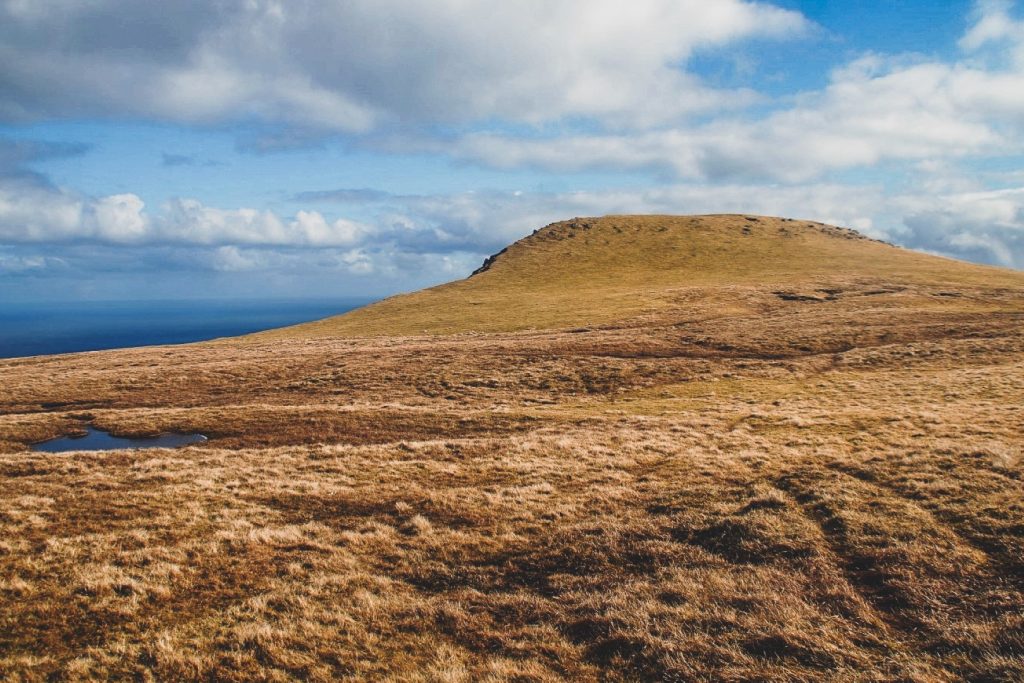

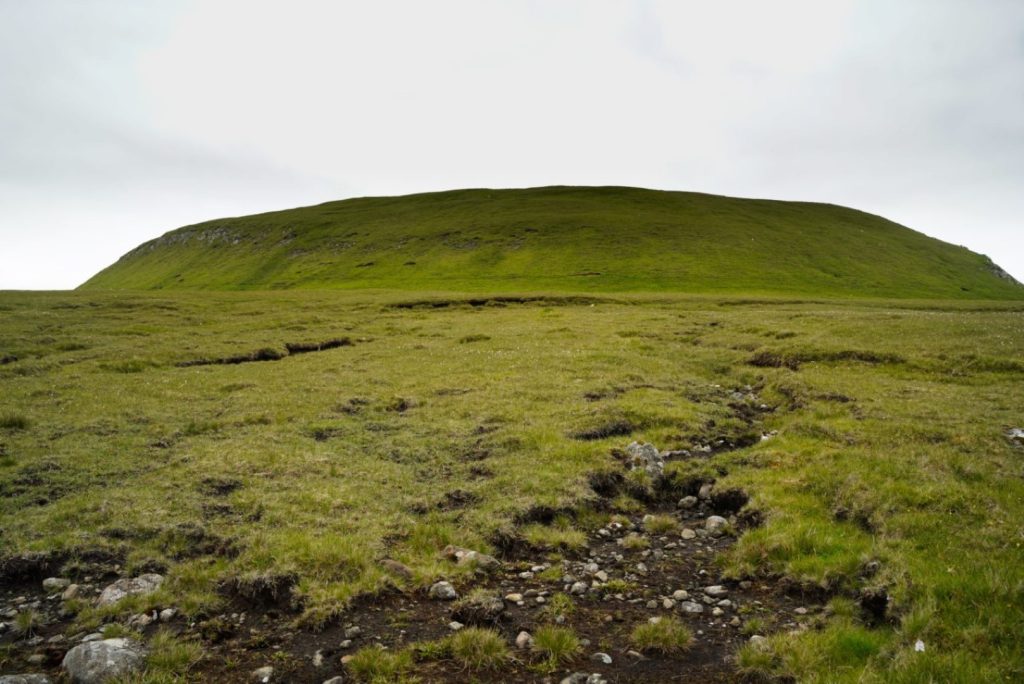
Beaches on Nólsoy
Malarendi, the village beach
Nólsoy doesn’t have the beautiful beaches that other islands such as Sandoy and Vágar have, but there is a small sliver of sand in the village which is very popular with locals on a sunny day. It’s also the best place to take a swim on Nólsoy!
Neystanes, a stoney beach with a cave
A few kilometres up the west coast from Borðan Lighthouse lies the small stoney beach of Neystanes. It’s possible to see the beach from the hills above, but as there’s also a cave in the cliffs near the beach, a boat trip would be the best way to explore it!
Sea stacks and skerries on Nólsoy
Kapilin
Nólsoy is not renowned for its sea stacks but there is one approximately 100 metres from the southwestern cape. Kapilin protrudes above the ocean in front of Nólsoy Lighthouse and can easily be spotted on a hike there. The best view of the sea stack is found approximately halfway on the hike between Nólsoy Lighthouse and Borðan Lighthouse. See the route description below.
RIB62 occasionally offers boat trips around Nólsoy where a climb up Kapilin can be included. See more here!
Flesin á Høsmøl
Flesin á Høsmøl is a small skerry located in front of Neystanes beach, a few kilometres up the west coast from Borðan Lighthouse. The skerry is best seen (and perhaps explored) from a boat, but it can also be seen from the hills above.
Skerries at Seiðagjógv
Just south of the village by the Seiðagjógv gorge is a collection of skerries. They’re very close to the coast so you have to walk down close to the shore to be able to see them.
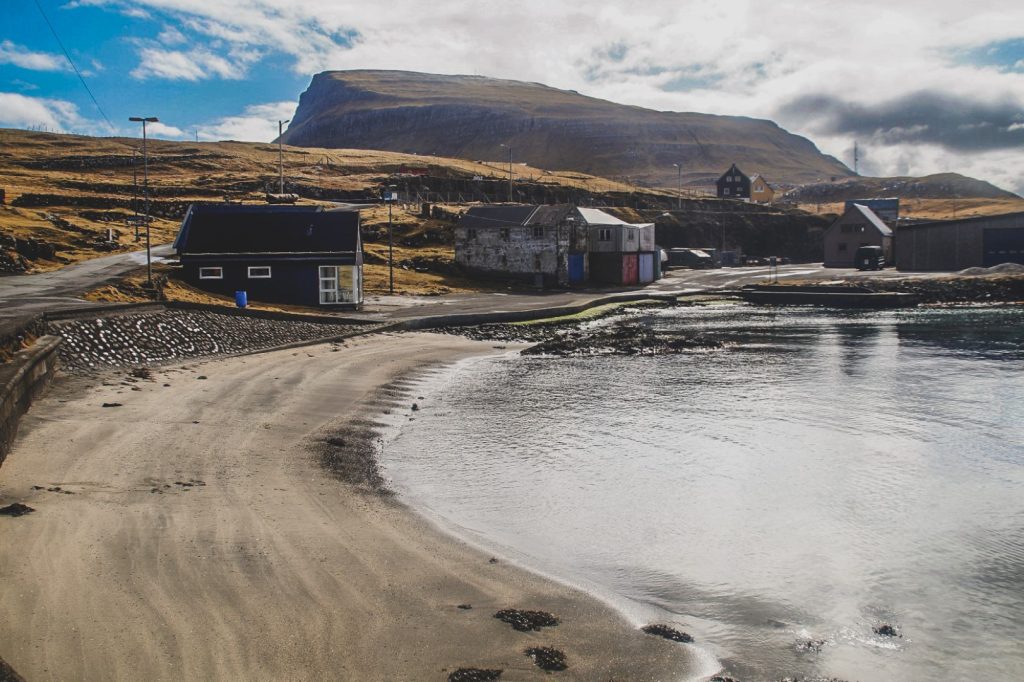
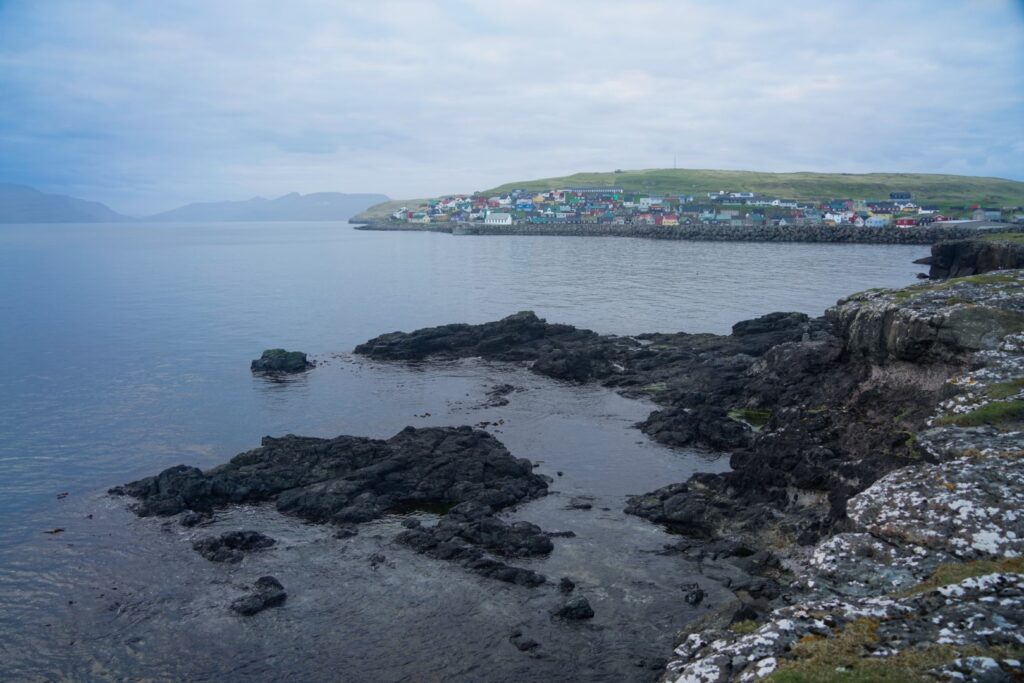
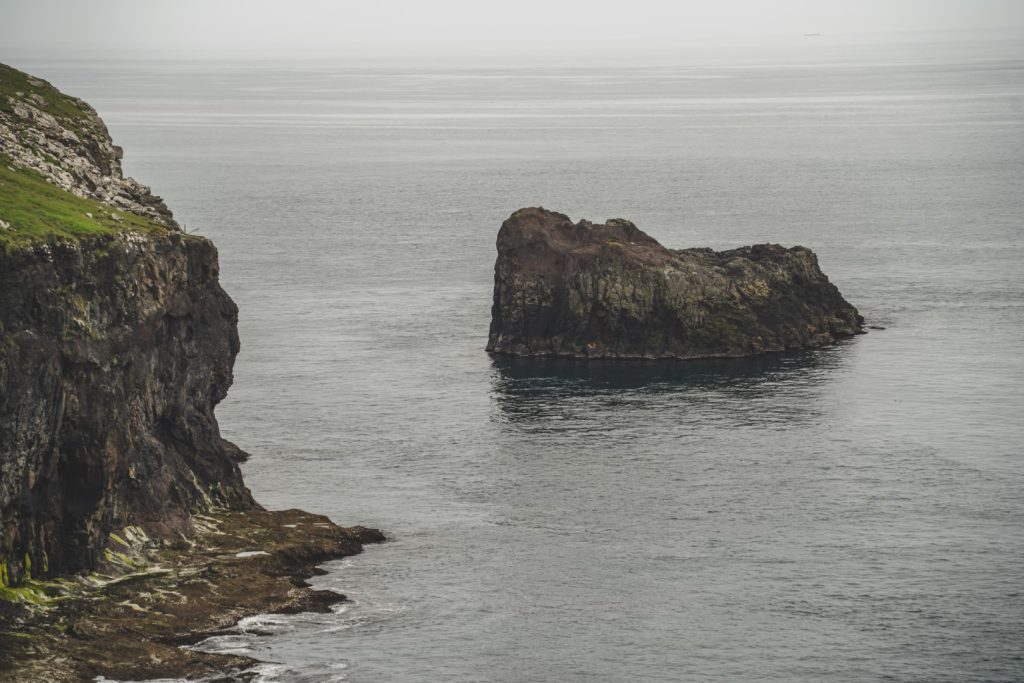
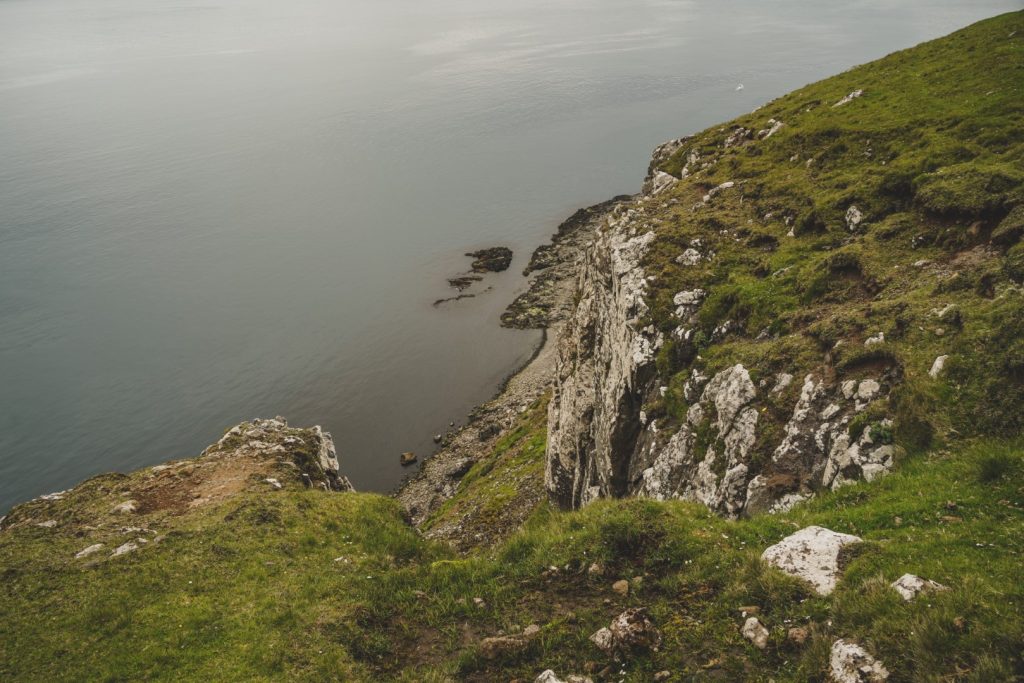
Gorges on Nólsoy
There are a few small gorges on Nólsoy, both in the north on Stongin and in the south, especially along the west coast.
- Gjógvin á Borðuni is the southernmost gorge on Nólsoy, located approximately 200 metres north of Borðan Lighthouse.
- Fiskigjógv is a small gorge on the west coast, located approximately 600 metres north of Gjógvin á Borðuni.
- Hásteinsgjógv is a dramatic and very scenic gorge on the east coast, located approximately 800 metres north of Nólsoy Lighthouse. This is a great place for puffin spotting in the summer!
- Farsælagjógv is a small gorge on the east coast, located approximately 1,2 kilometres north of Hásteinsgjógv.
- Høsmøl is a small gorge on the west coast, located directly above Neystanes beach and the Flesin á Høsmøl skerry.
- Kergjógv is a small gorge on the west coast, located approximately 200 metres north of Høsmøl.
- Leirgjógv is a small gorge on the west coast, located approximately one kilometre north of Kergjógv.
- Seiðagjógv is a small gorge on the west coast, located just south of the village.
- Mánagjógv is the northernmost gorge on Nólsoy and is a very scenic place with great opportunities for puffin spotting in the summer. It’s located at the very north of Stongin and requires a bit of rock climbing to reach.
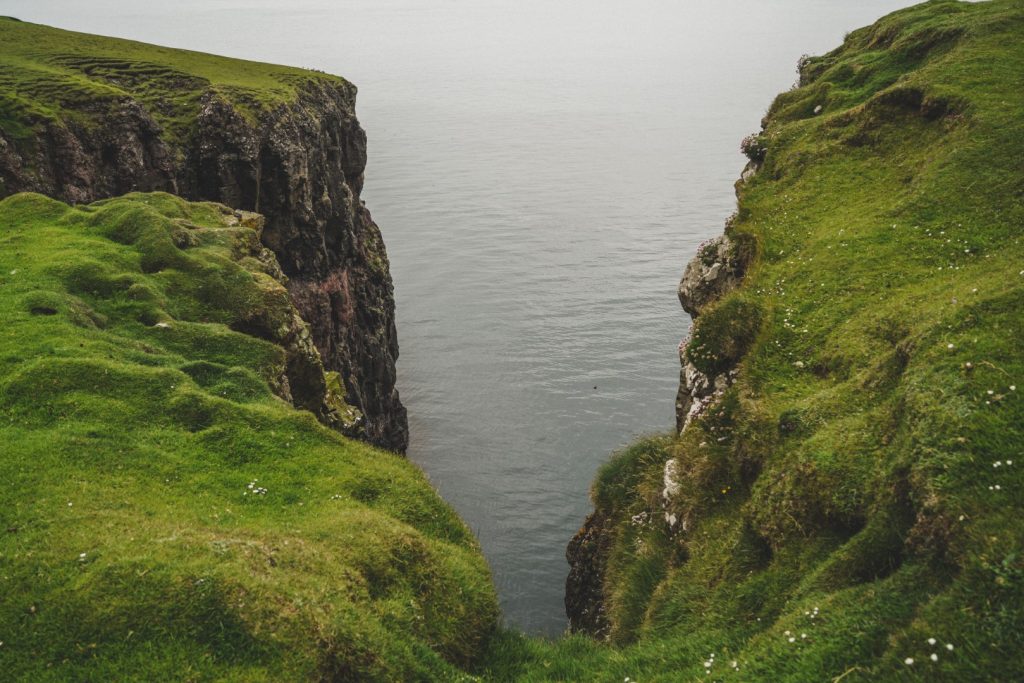
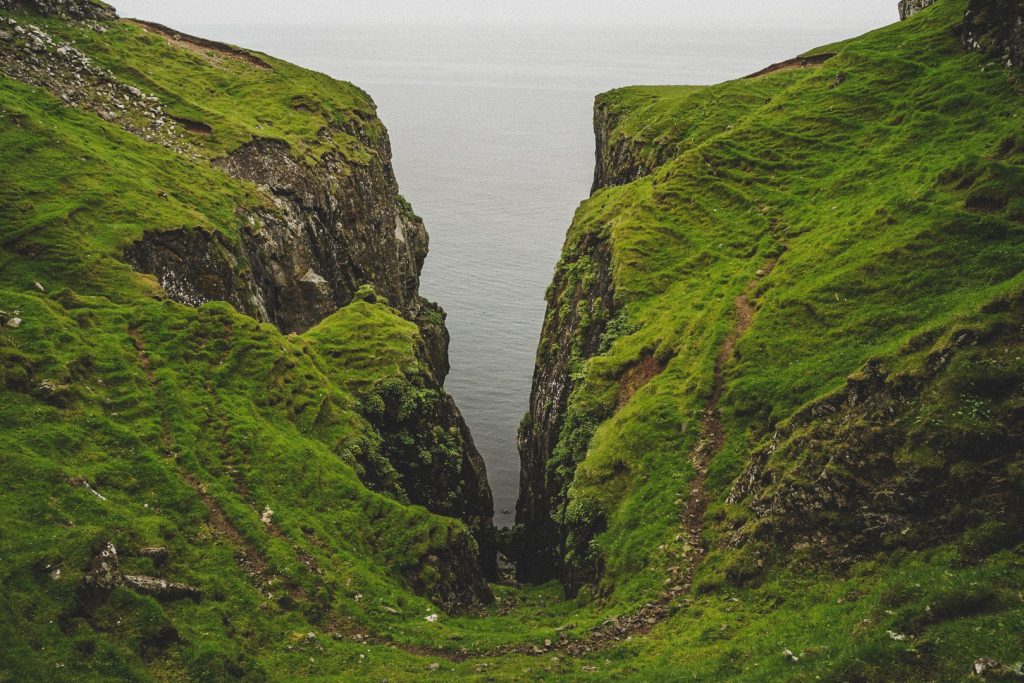
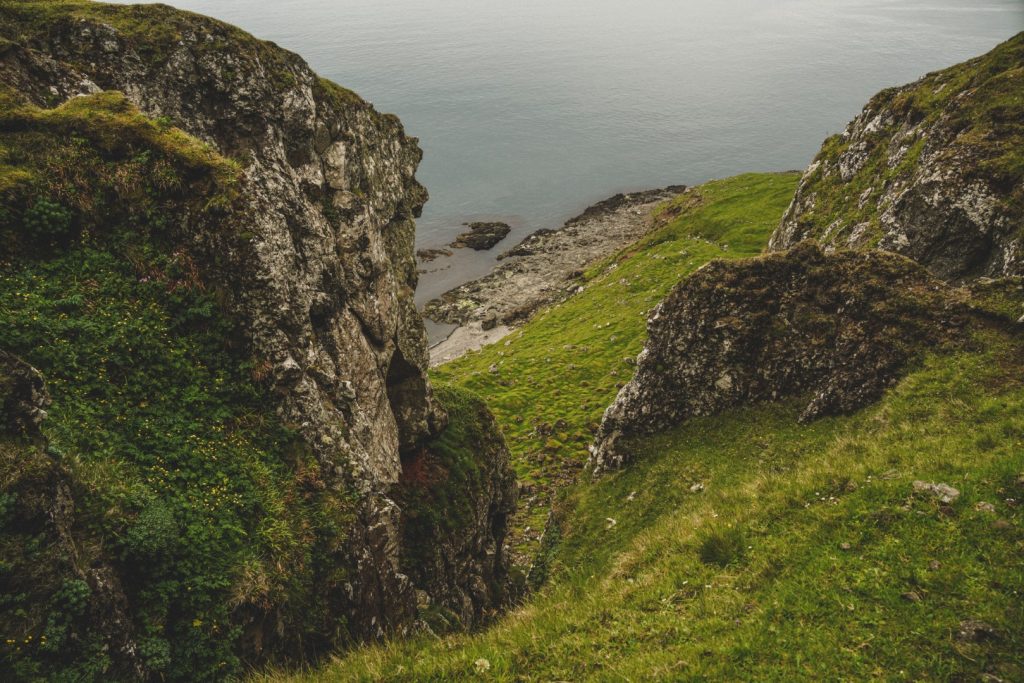
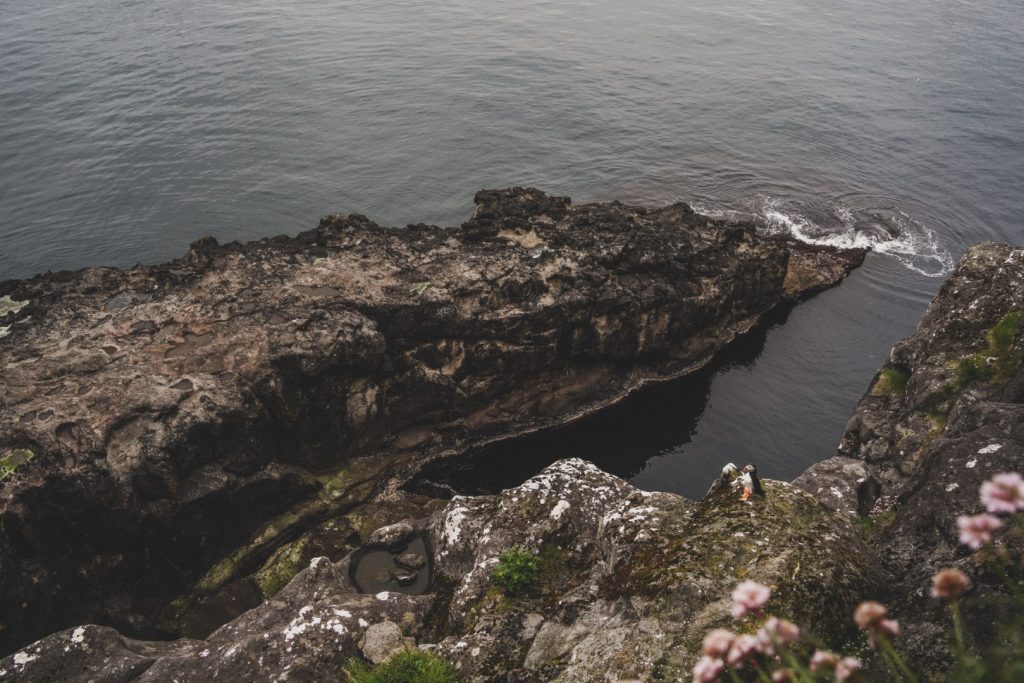
Lakes on Nólsoy
Nólsoy doesn’t have any big lakes, just a few small ones scattered about in the south, four of which are named:
- Steinavatn is the southernmost lake, located approximately 400 metres north of the abandoned dockyard at Stallurin.
- Halavatn is the biggest lake on Nólsoy, located approximately 500 metres north of Steinavatn.
- Tjørnin á Reyðastíg is a small lake, located approximately 300 metres west of Halavatn.
- Álkurðarvatn is a small lake with several streams originating from it, located approximately 500 metres northeast of Neystanes beach.
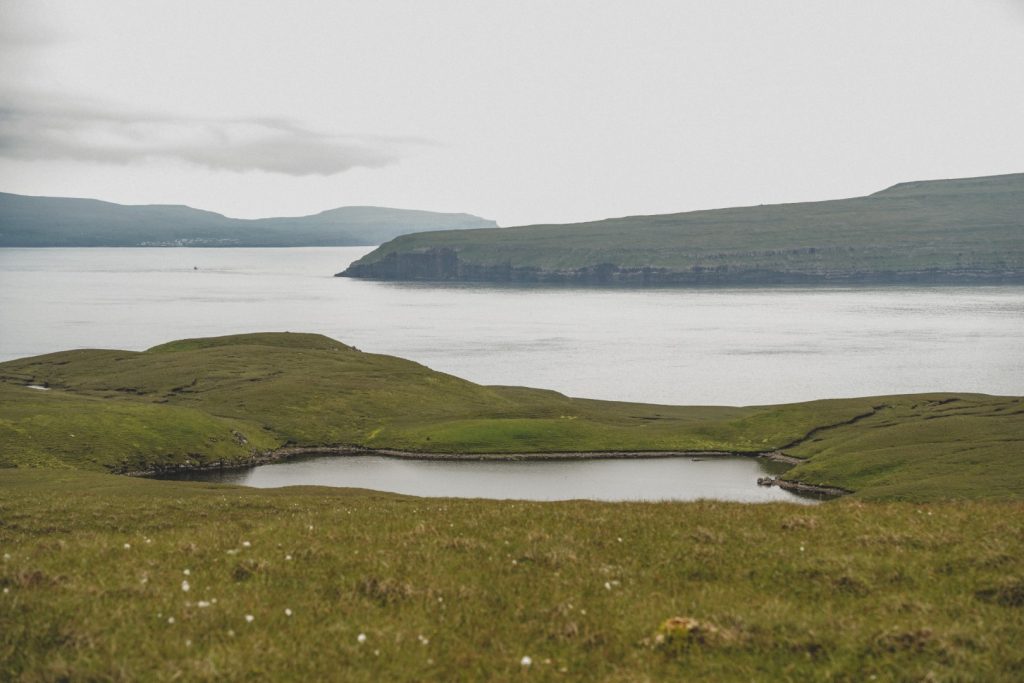
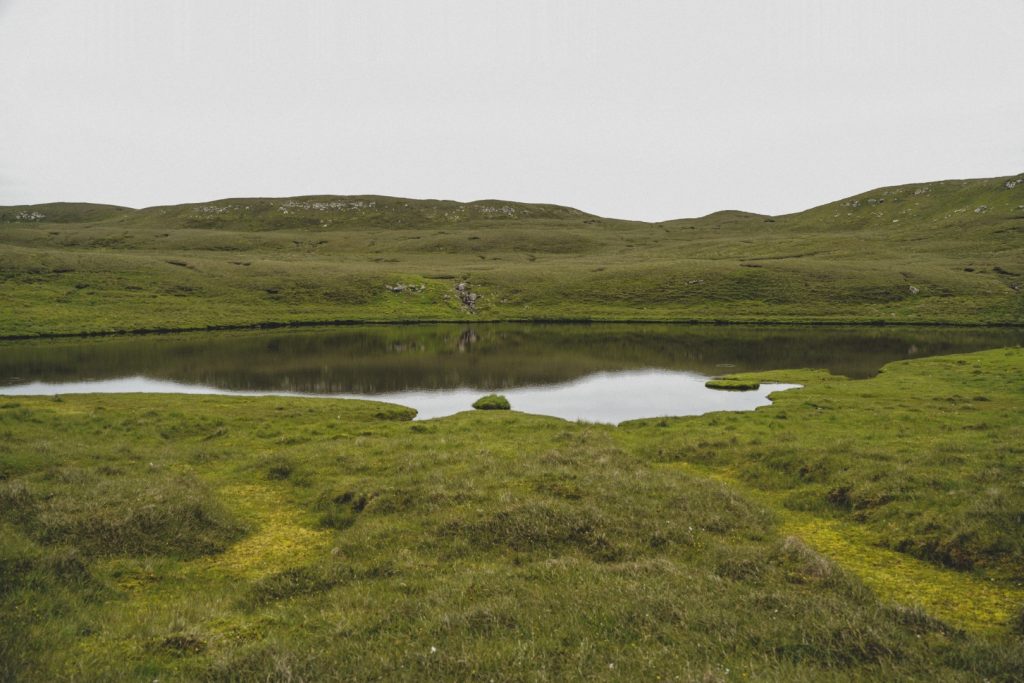
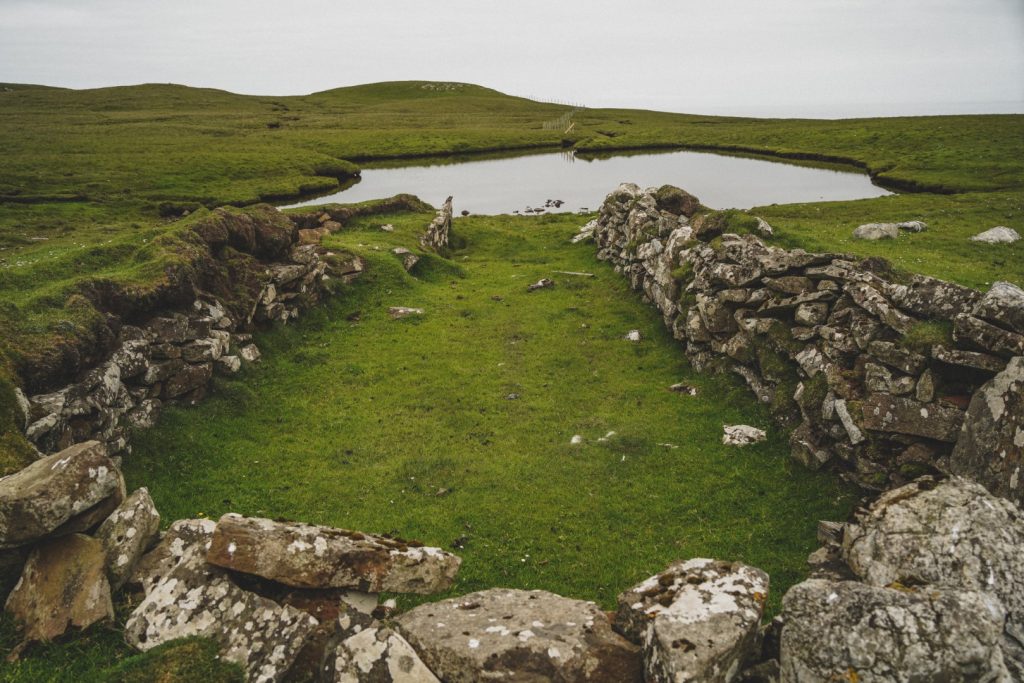
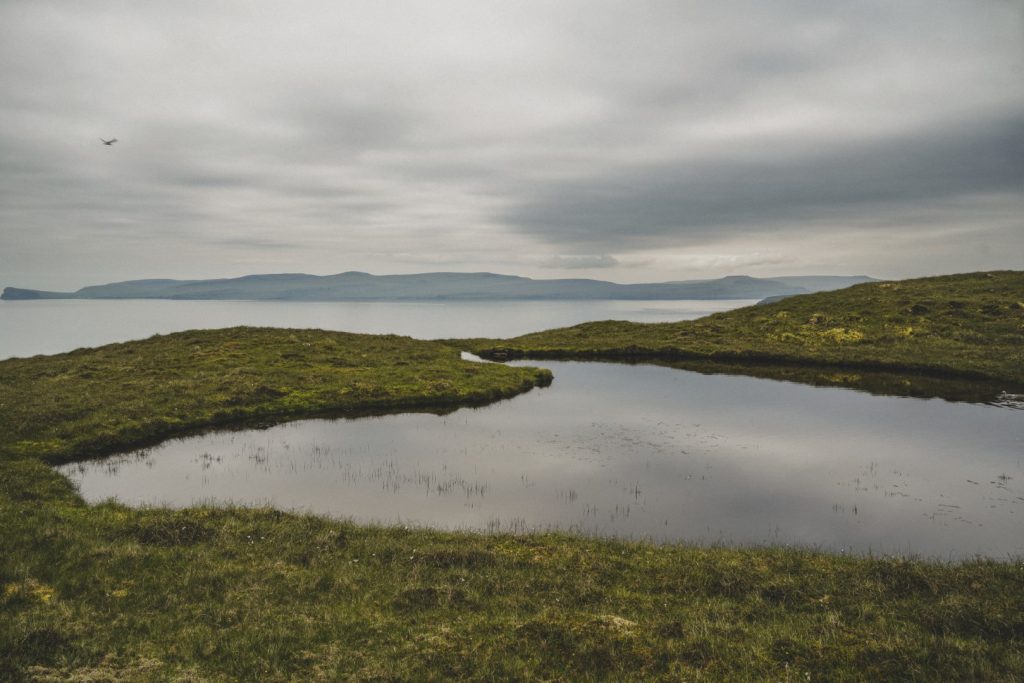
Birds of Nólsoy
Despite what most tourists think, Mykines is not the most important island for birds in the Faroe Islands – Nólsoy is!
Nólsoy’s east coast is home to the world’s largest colony of European Storm Petrels with approximately 50,000 pairs. The sea cliffs are also important breeding places for the Atlantic Puffin with approximately 30,000 pairs, as well as the Black-legged Kittiwake, Northern Fulmar, Black Guillemot, Arctic Tern, Oystercatcher (the national bird of the Faroe Islands), Whimbrel, Golden Plover, Northern Wheatear, Meadow Pipit and more rarely Red-necked Phalarope and Red-throated Diver. Just like Mykines and Skúvoy, Nólsoy is a protected Ramsar site.
Local resident Jens Kjeld is an expert on birds and Nólsoy’s fauna as a whole, and he tracks the birds continuously. Click here to read his blog about the birds on Nólsoy! If you’re interested in learning more about Nólsoy’s fauna during your visit, you can also stop by for a look at his museum and a chat for the price of just 30 DKK! You can also read much more about the birds of the Faroe Islands in this pdf!
Puffin spotting on Nólsoy
Nólsoy may not be the obvious choice as a puffin spotting destination, but I assure you it’s (almost) as good as Mykines – and a lot easier to reach! In fact, I’d go as far as to say that Nólsoy is the hidden puffin paradise of the Faroe Islands!
Puffins can be spotted on the cliffs and in the water at the northern end of Stongin, an easy 1,5-kilometre hike north of the village, but extending your hike around the east coast of Stongin will give you even better opportunities for puffin spotting! The best place to see puffins in flight (not on cliffs) is on the east side of Eggjarklettur. And if you’re up for a long hike, Hásteinsgjógv in the south is another excellent place to see puffins resting on the cliffs.
Read my hiking descriptions below to learn how to reach all of the above-mentioned places!
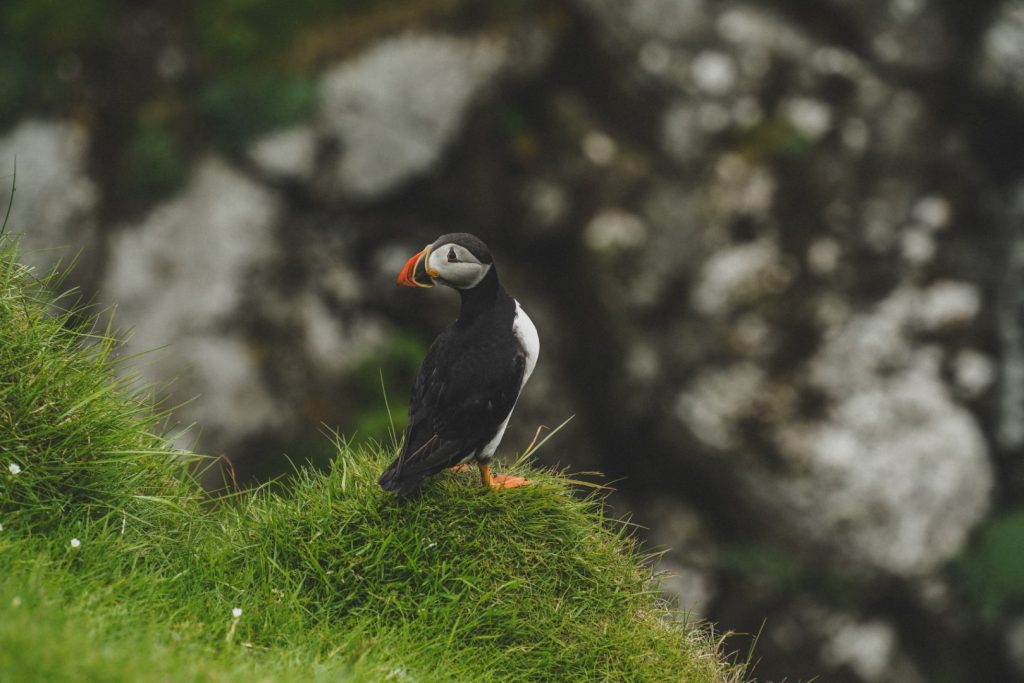
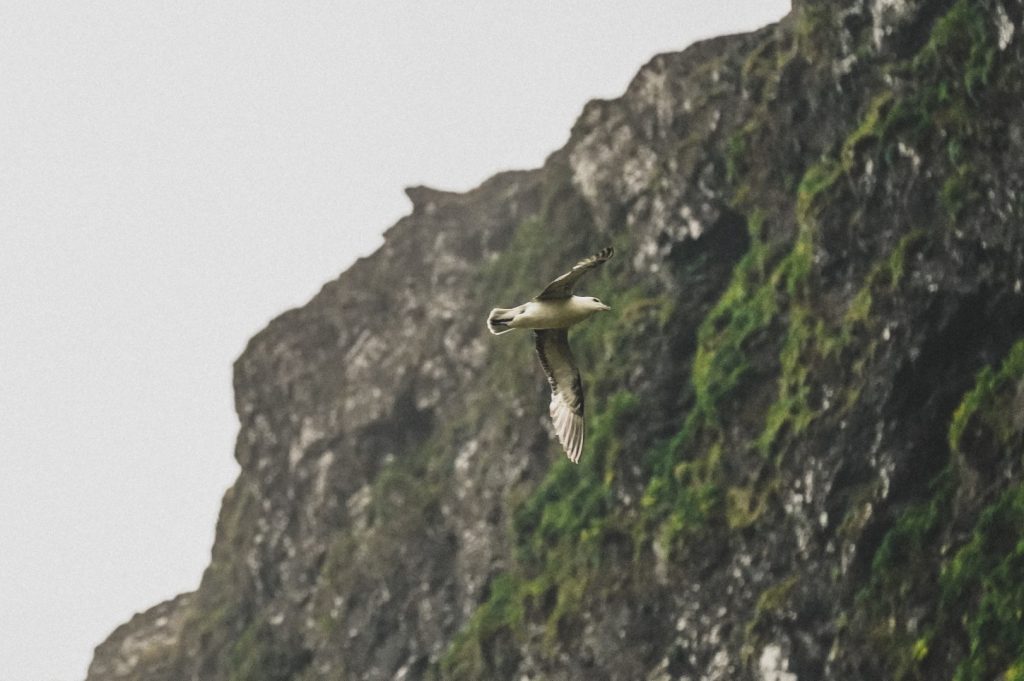
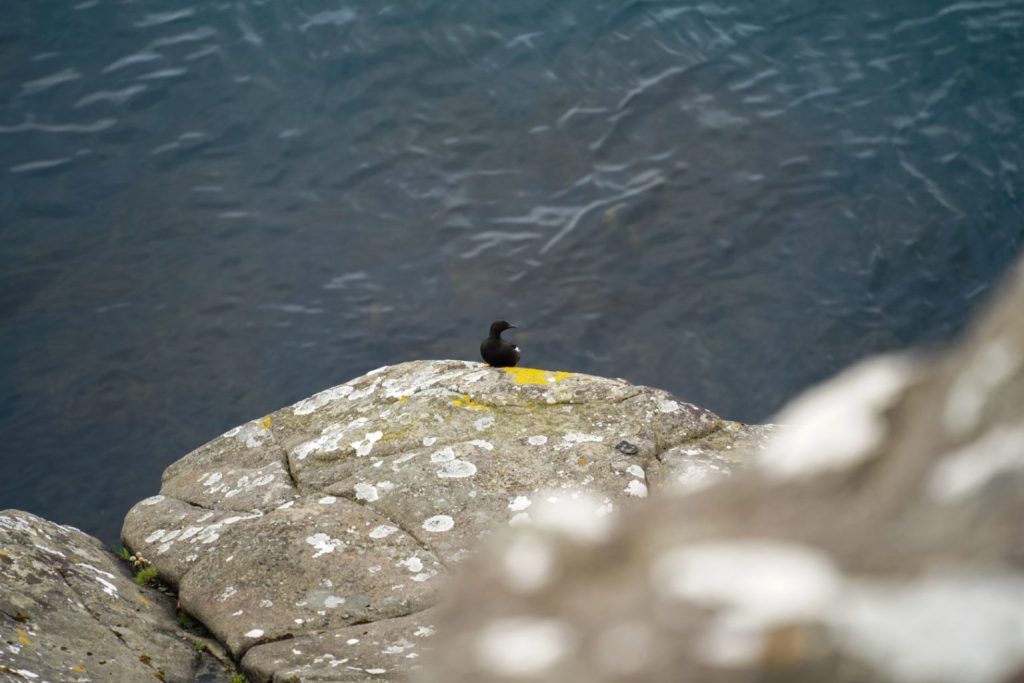
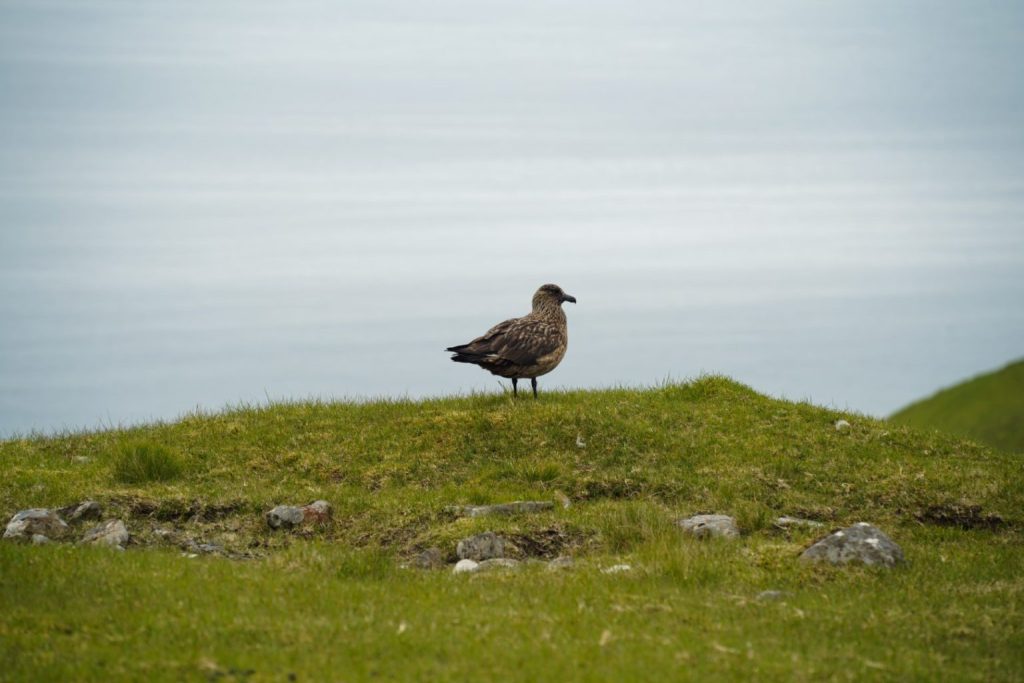
Hiking routes on Nólsoy
There are several great hiking trails on Nólsoy; even though the island is small, you can spend days exploring its gorgeous nature.
Around Stongin (the northern end)
Enjoy an easy hike out to Boðin, the northernmost point of Nólsoy, where you’ll find Flaggstongin and the scenic Managjógv gorge. Continue along the east coast of Stongin where you’ll in no doubt spot many puffins if you’re hiking during the summer. Nólsoy is the second puffin paradise of the Faroe Islands, and Stongin is the easiest place to see them! You’ll see them resting on the cliffs, swimming in the sea below and flying to and from their nests with food for their pufflings.
The views on this hike are incredible as you can see many of the other islands, and if you end up at the windmill on top of Stongin, you’ll be rewarded with a lovely view of the colourful village below.
- Duration: 2-3 hours return
- Distance: Ca. 5 km
- Difficulty: Easy
A description of the hiking route can be found here.
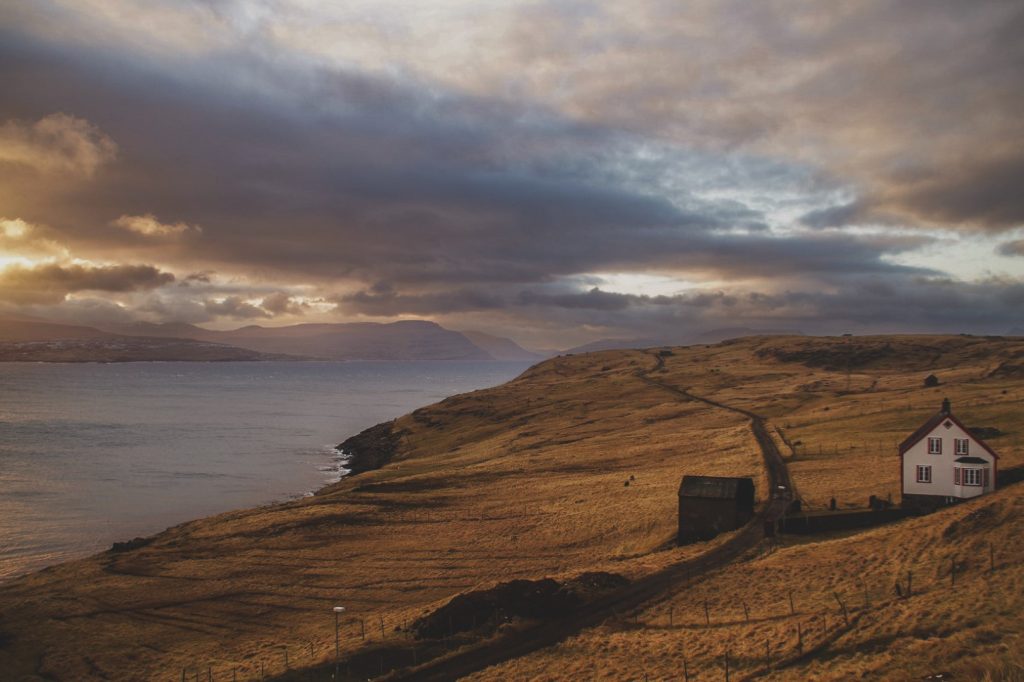
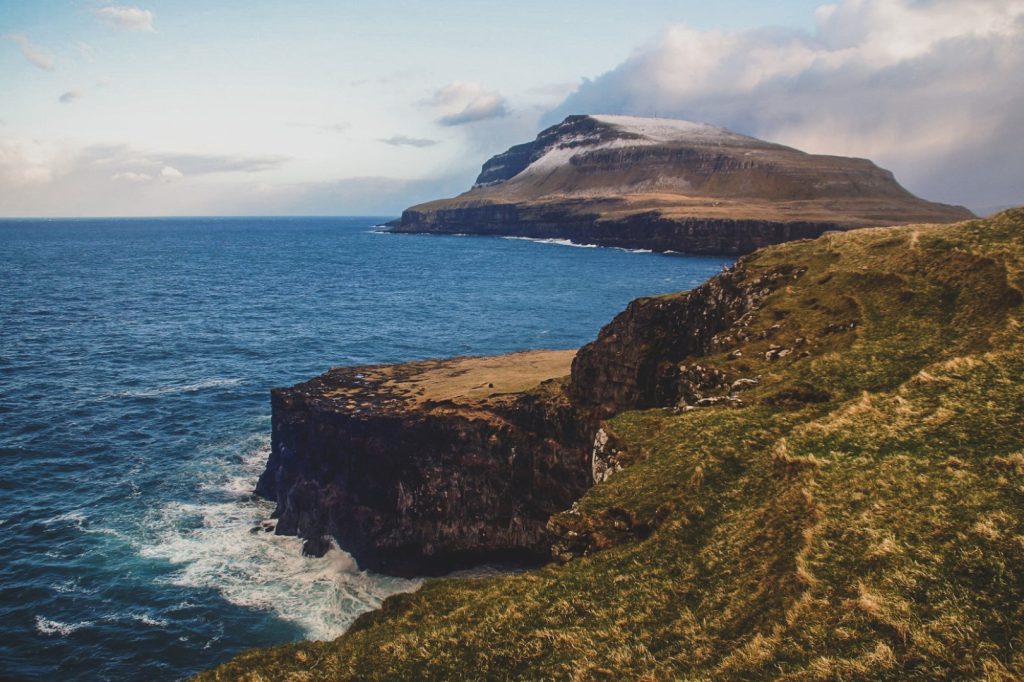
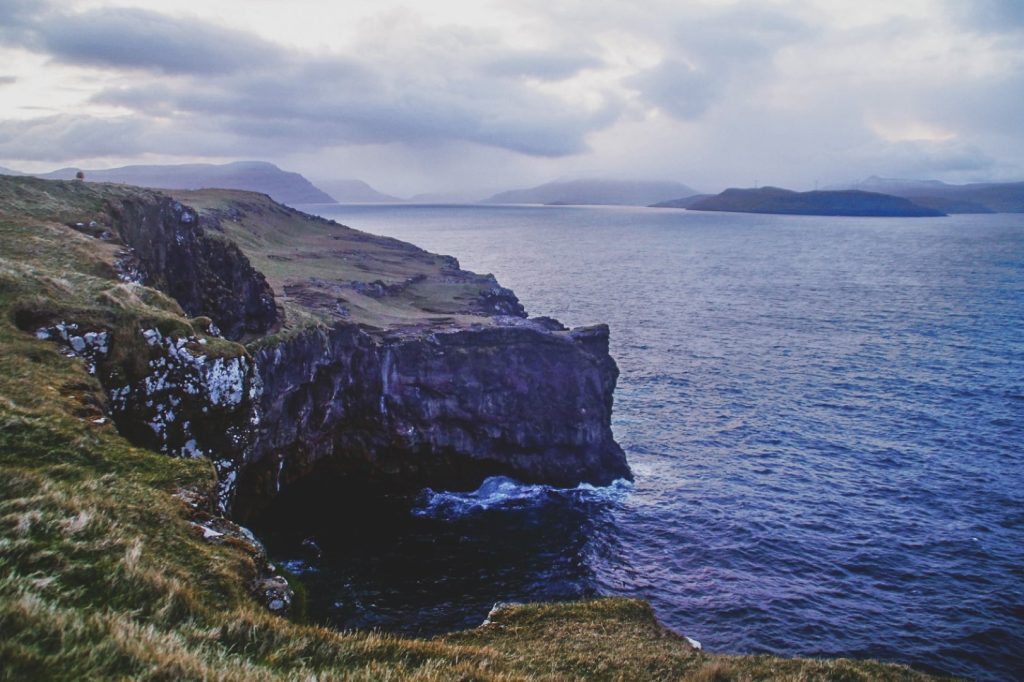
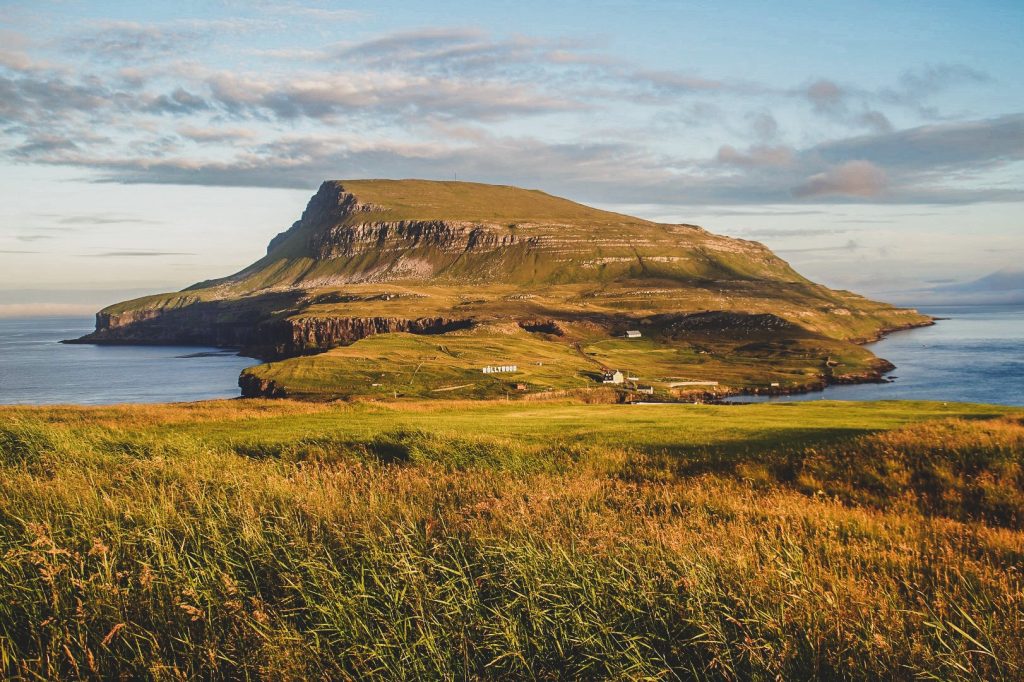
Along the East coast
Home to a huge vertical bird cliff, an insane view of the village with huge caves beneath it, and hardly any people except for bird enthusiasts, sheep herders and the odd adventurer, the East coast is the very best that Nólsoy has to offer. And it’s pretty spectacular.
A relatively well-hidden trail runs along the rocky East side of Eggjarklattur. Here, you can spot many different types of birds including puffins in flight. The terrain is more rugged than the West coast, and the path is quite steep in some parts. DO NOT venture beyond the beginning of Bolstaður if you’re without a guide, as the ground is mossy and full of rocks and hidden holes. Walking there is dangerous if you don’t know the area well.
- Duration: 2-3 hours return
- Distance: Ca. 6 km
- Difficulty: Moderate
A description of the hiking route can be found here.
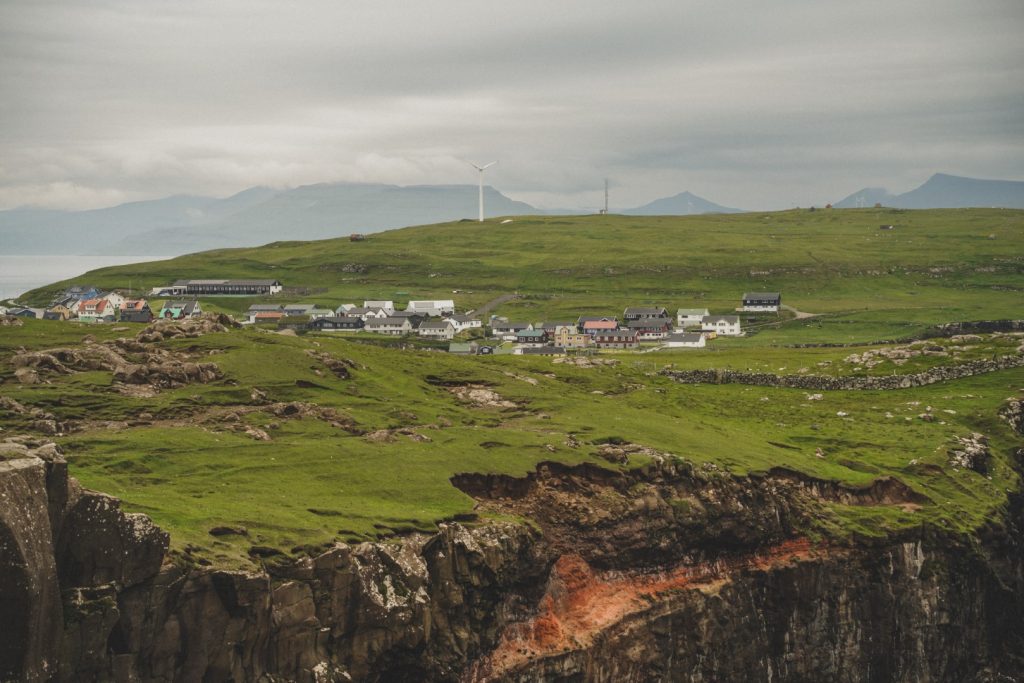
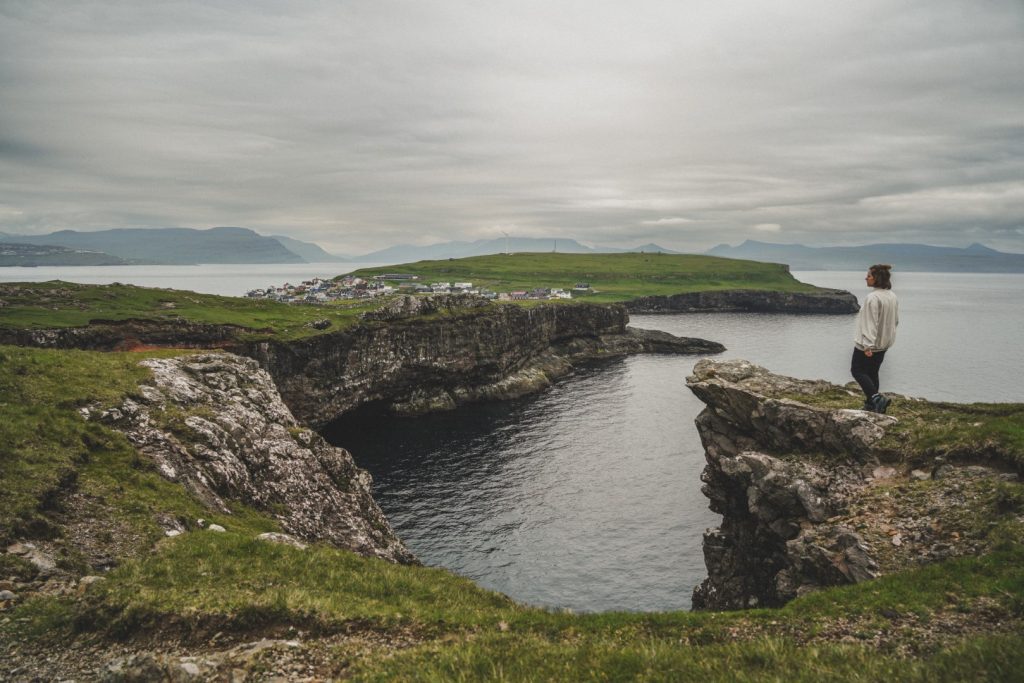
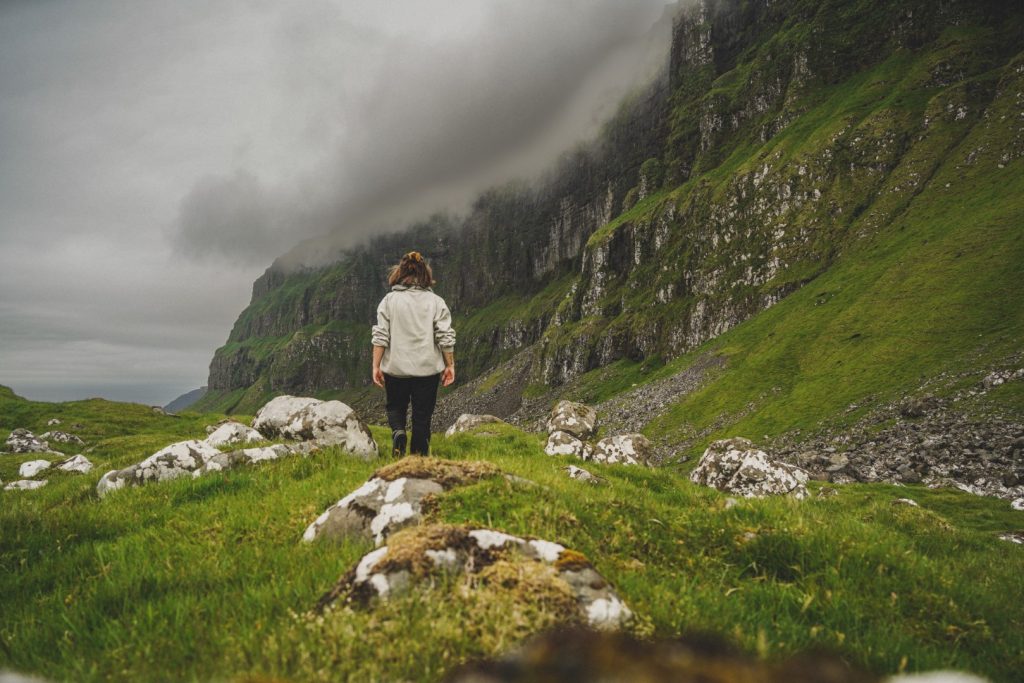

Up the summit of Eggjarklettur
Climb the highest mountain on Nólsoy at 372 meters! Compared to other mountains in the country, this is a relatively easy hike although there is no trail that goes right to the summit. You’ll be following the main hiking trail out of the village (the one that goes along the West coast to Borðan) until you find a good spot to start your ascent to the summit.
You can also combine this hike with the cliff views at the summit of Uppi á Manni (352 meters), which is only a short hike from the summit of Eggjarklettur.
- Duration: 2-3 hours return
- Distance: Ca. 5 km
- Difficulty: Moderate
A description of the hiking route can be found here.
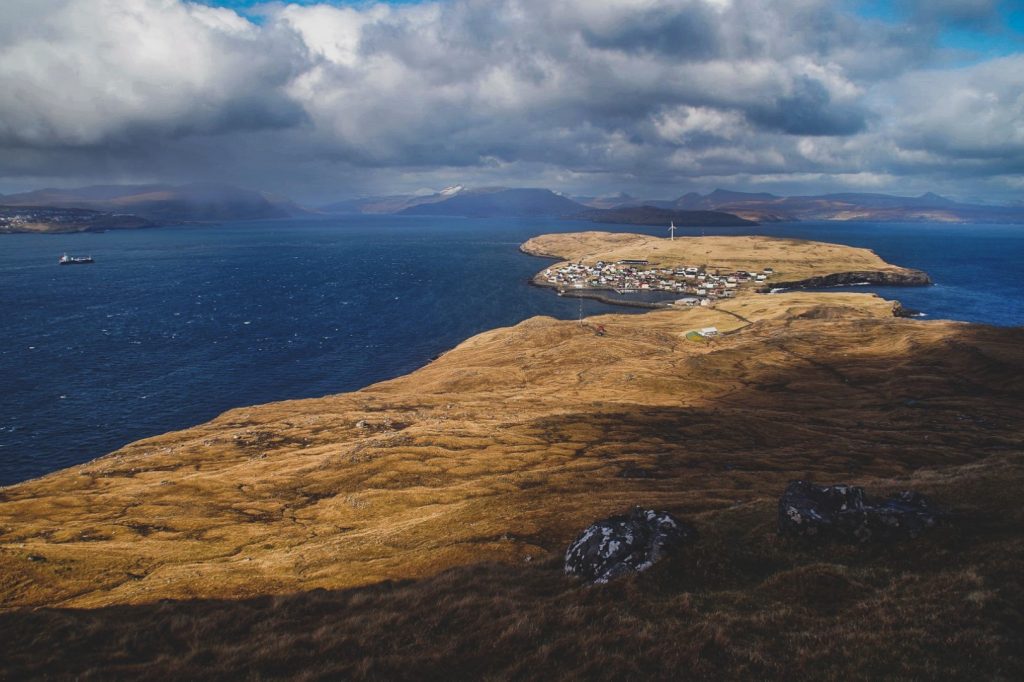
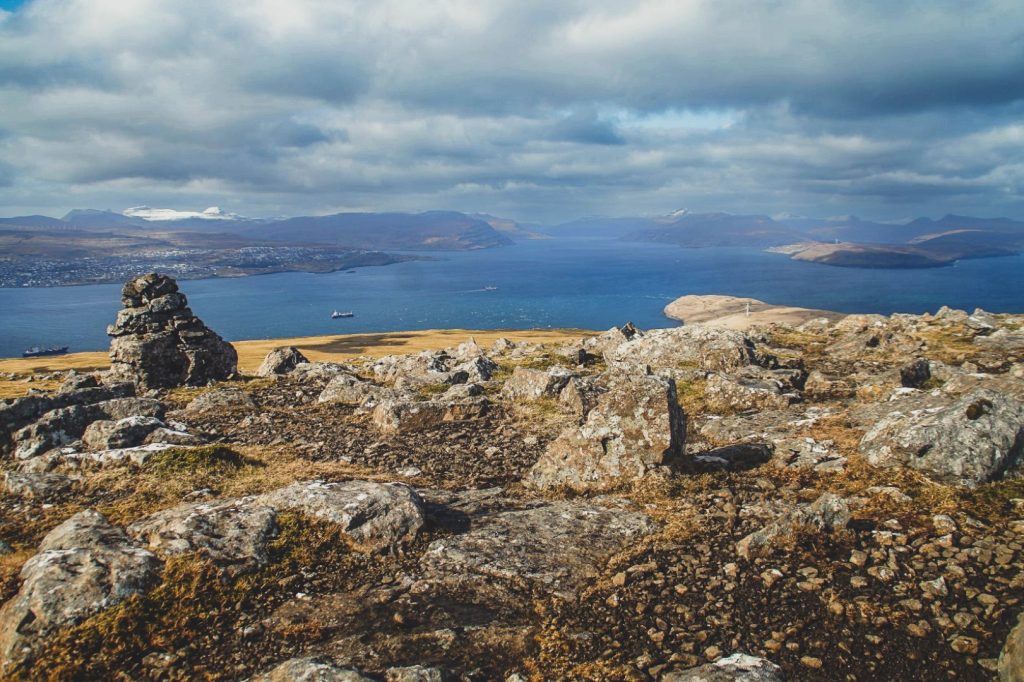
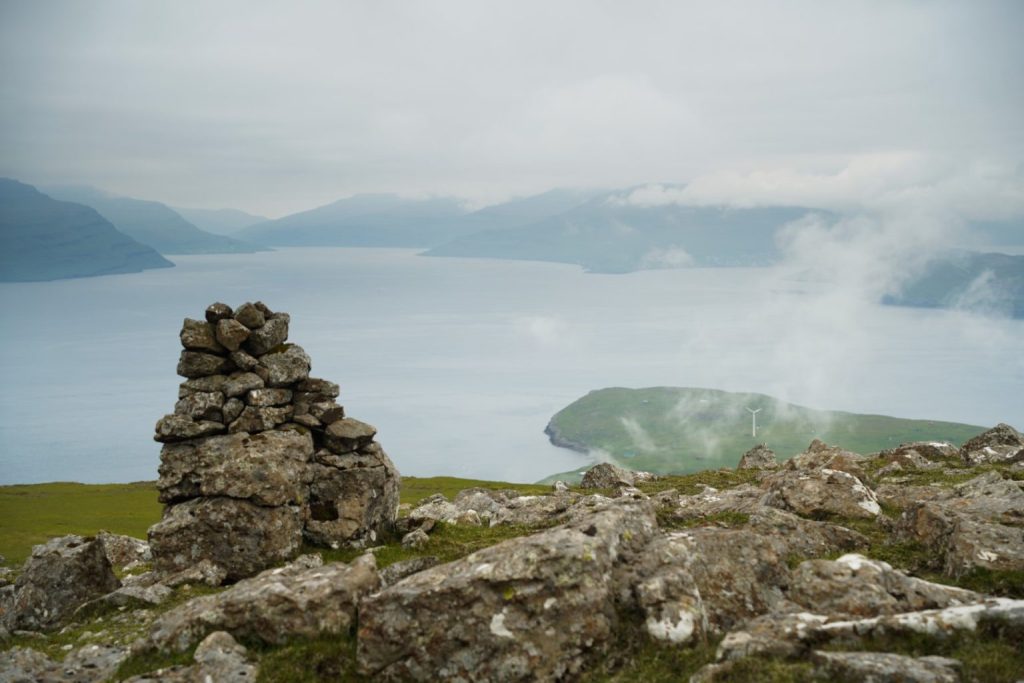
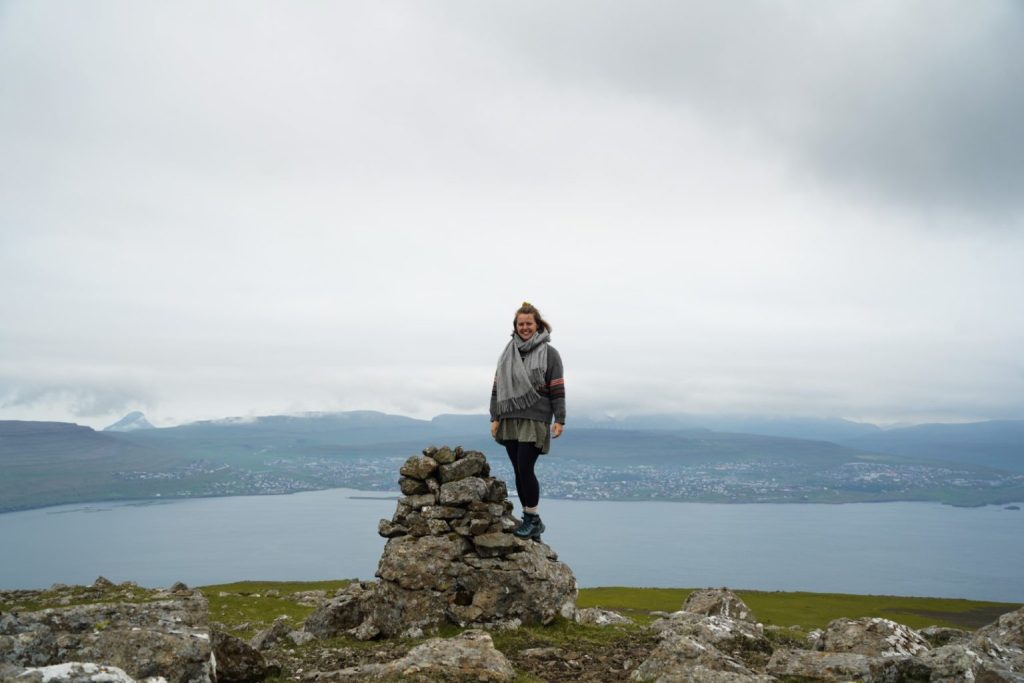
To the lighthouses in the south
The only official hike on Nólsoy is also the most popular one as it goes out to the famous ‘lighthouse at the end of the world’ at Nólsoyarviti, but it should be combined with the lesser known lighthouse at Borðan, the southernmost end of the island.
The trail is very easy to follow, and apart from the steep ascend halfway up Mt. Eggjarklettur, it’s also very easy to hike. The hike is loooong and some might think it’s slightly boring spending so much time hiking through meadows, but in my opinion it’s very worth it as the southern end of Nólsoy is an incredibly peaceful and beautiful place.
- Duration: 4-6 hours
- Distance: Ca. 15 km
- Difficulty: Easy, but quite long.
A description of the hiking route can be found here.

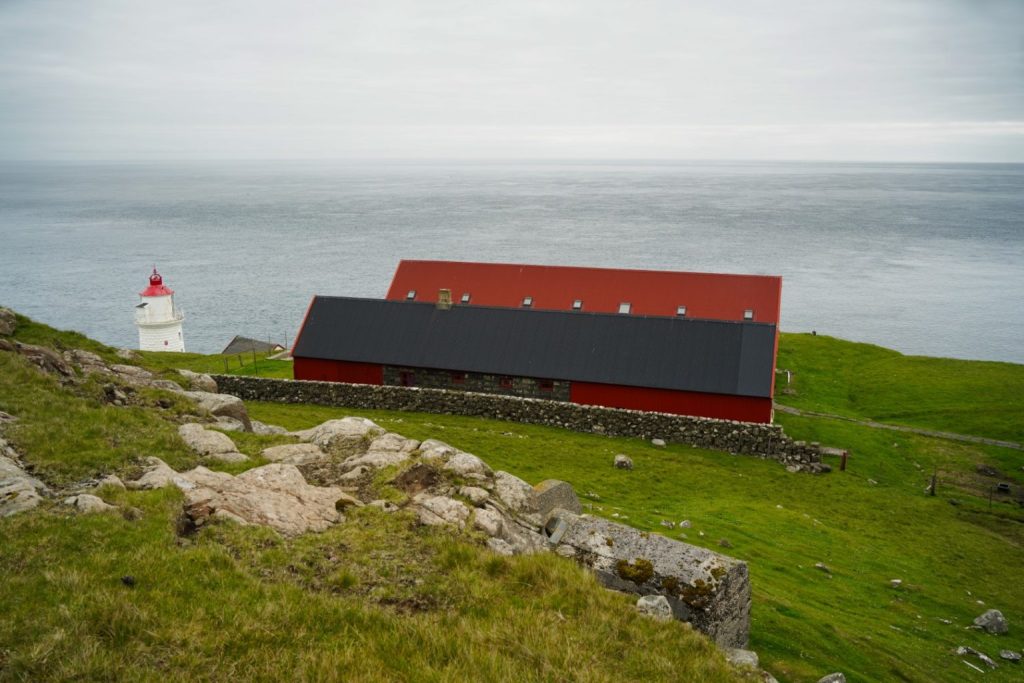
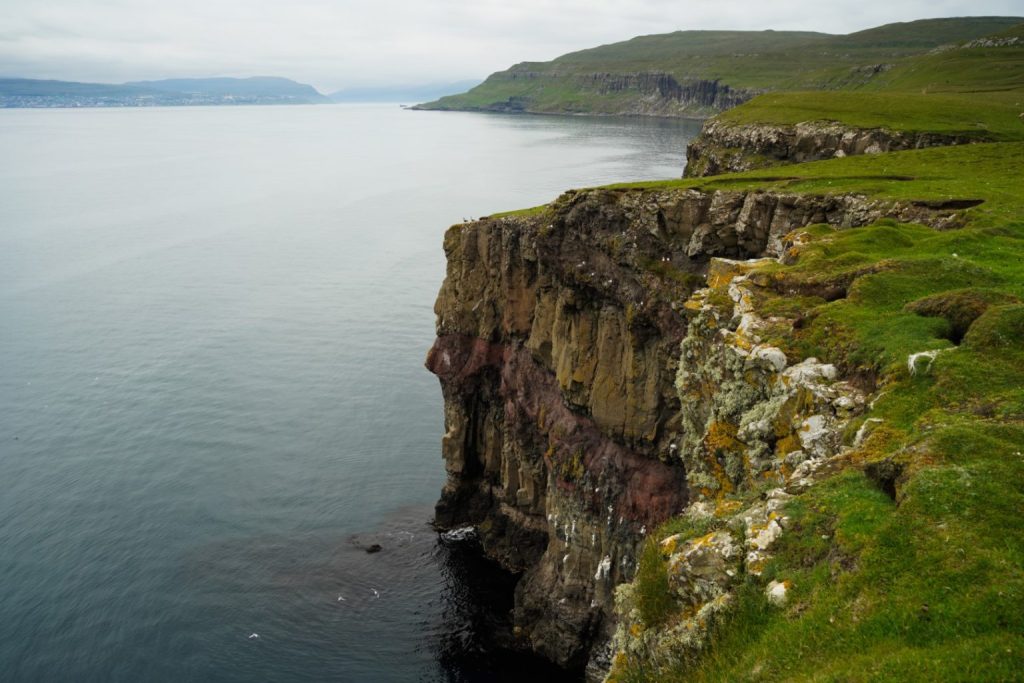
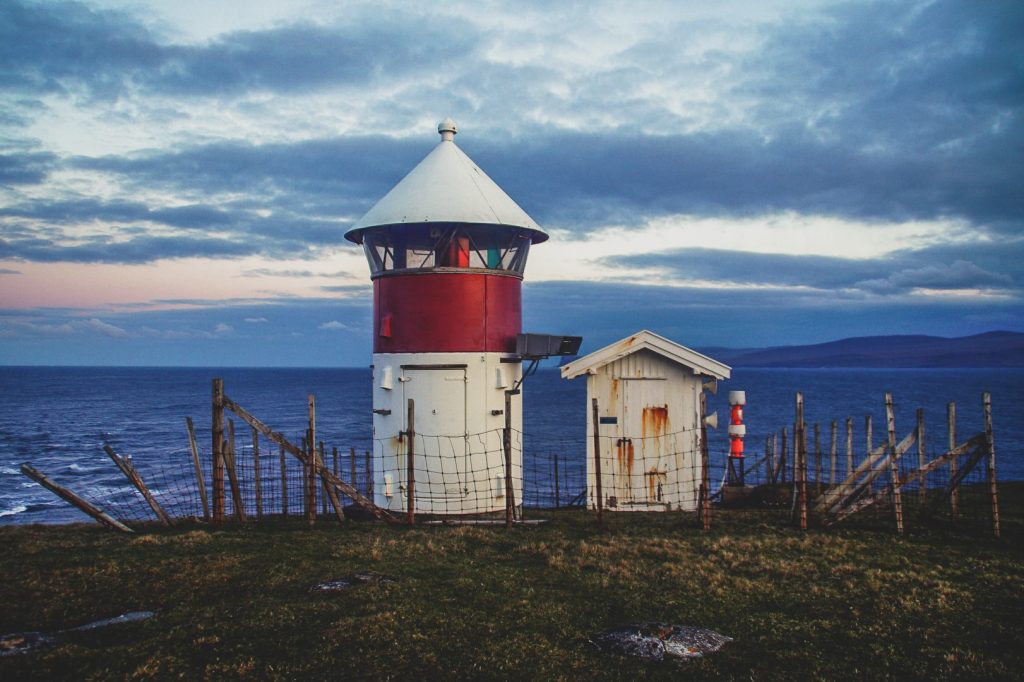
Over all four mountains to the lighthouses in the south
This has to be the ultimate hike on Nólsoy. The route takes you from the village to the summit of Eggjarklettur (372 m.), and then follows the mountain ridge to the peaks of Uppi á Manni (352 m.), Skúvafjall (234 m.) and Líðarfjall (152 m.), past the dramatic Hásteinsgjógv gorge, before reaching the two lighthouses at the southern end of the island. The hike ends with a long stretch along the west coast with its many small gorges.
On this hike, you’ll be able to tick off all four of Nólsoy’s peaks, explore some of the islands’ most beautiful gorges, spot puffins in the summer, swim in the small lakes and visit the two lighthouses. It’s a super long hike, but it’s not technically challenging and it’s the best route to explore as much of Nólsoy as possible in one day.
- Duration: 9-11 hours
- Distance: Ca. 16 km
- Difficulty: Moderate
A full description of the hiking route can be found here.
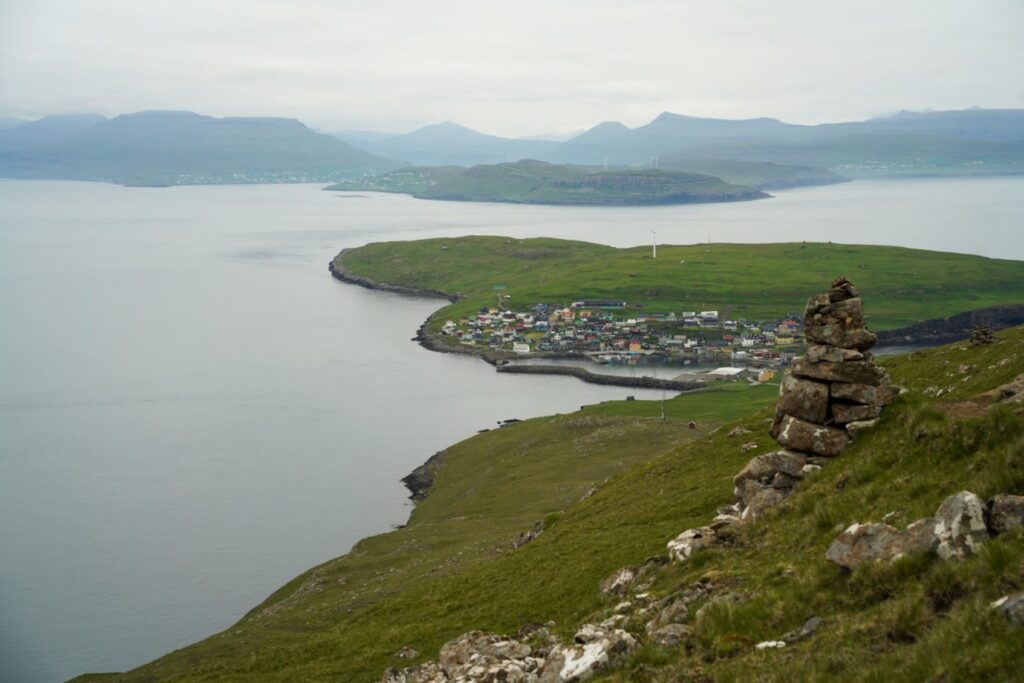
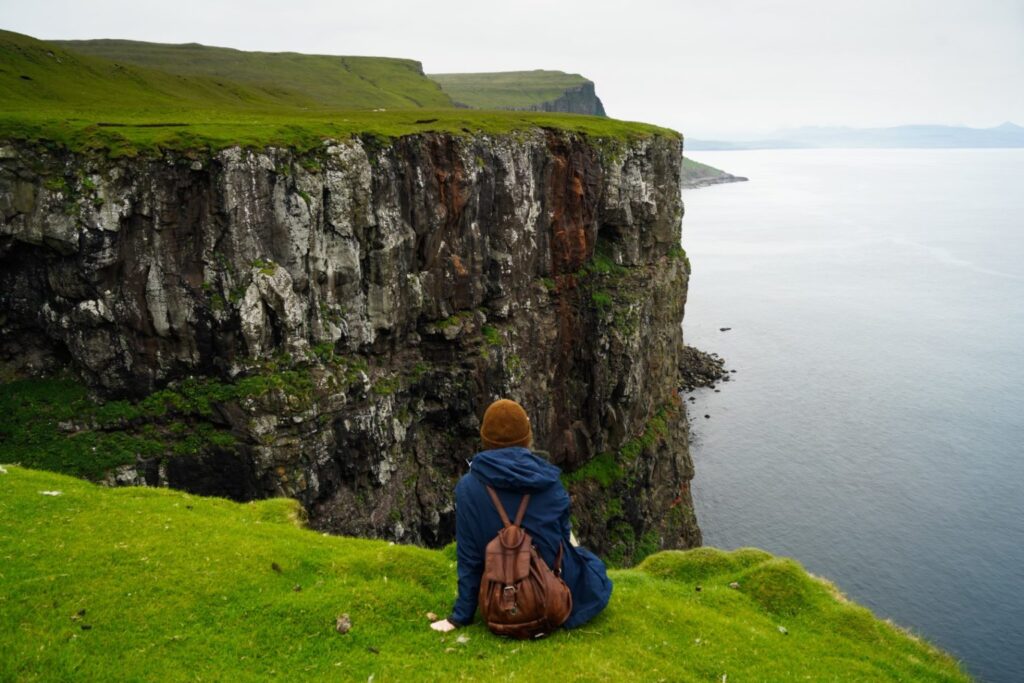
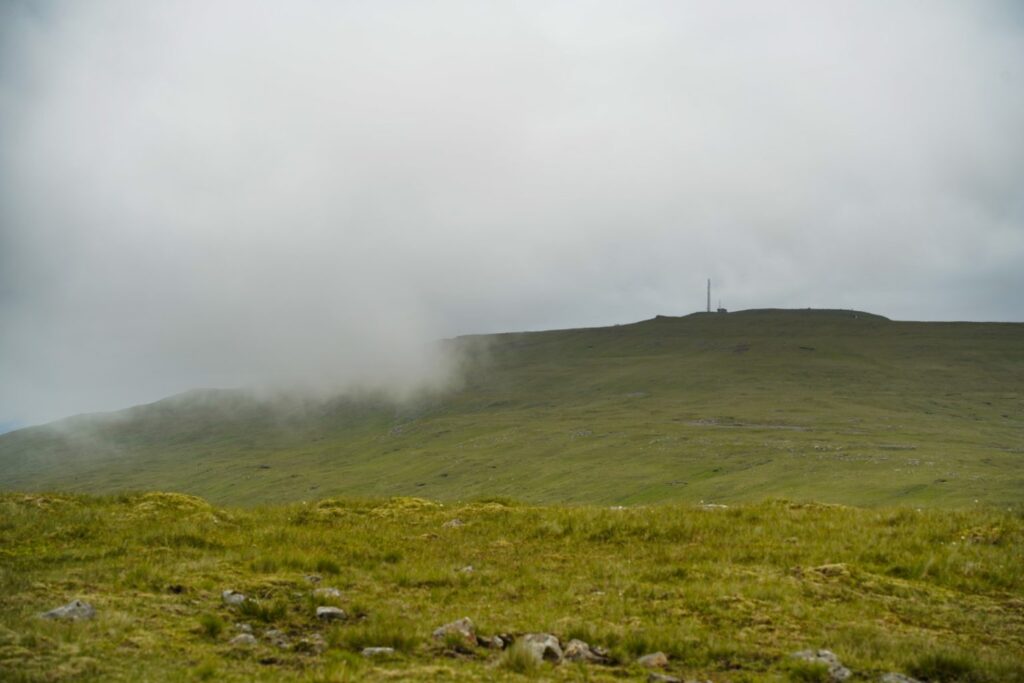

Guided tours on Nólsoy
Storm petrel tour
Go on an adventurous guided hike in the dark to the world’s largest European storm petrel colony on the East coast. The bird enthusiast Jens Kjeld will be your guide!
The 6 km guided hike runs from June to September. The prices haven’t been updated since 2014, but you can read more about this hike and contact Jens Kjeld here.
Explore Nólsoy by boat
Enjoy a unique trip around Nólsoy by boat where you’ll get to see the many hidden caves of the islands. It’s the perfect way to spot the seals, puffins and other seabirds that thrive on and around Nólsoy.
The two-hour tour is available from April to October. The price starts at 2,100 DKK for 1-3 people. Read more here!
Sail around the island with Norðlýsið
Take a trip on the historic scooner Norðlýsið during the summer, where the captain will sail you around the island before stopping in the village.
The three-hour tour is available from May to August. The price is 850 DKK per person for adults and 425 DKK for children. Read more here.
An adventurious RIB experience
RIB62 occasionally offers boat trips around Nólsoy in the high season. Enjoy a speedy and fun trip into the caves of the island.
Check their website for dates, prices and more information.

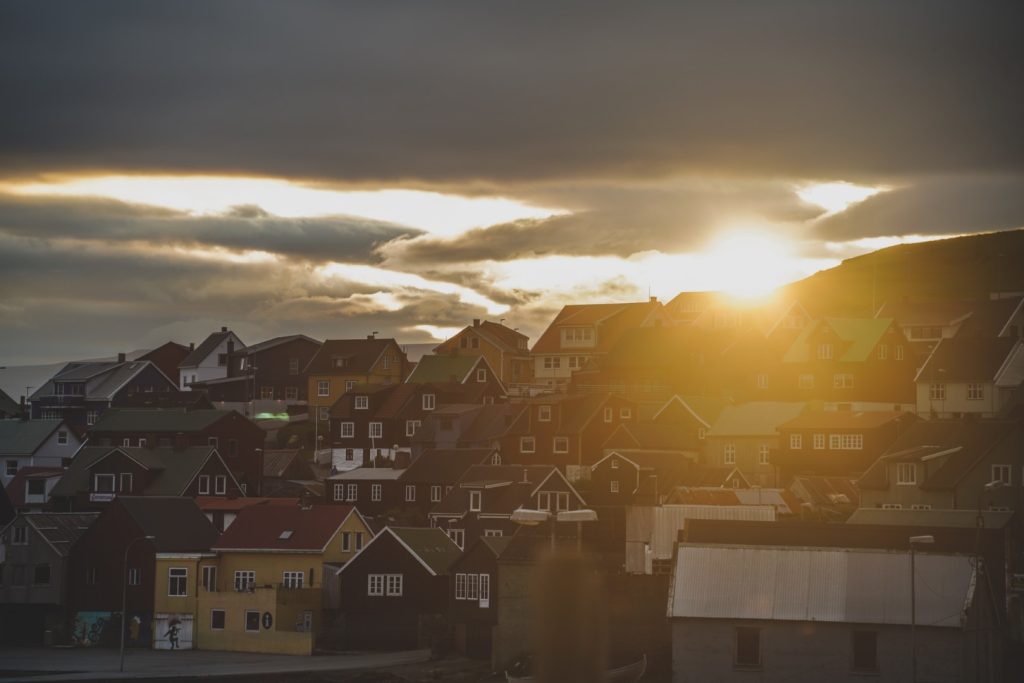
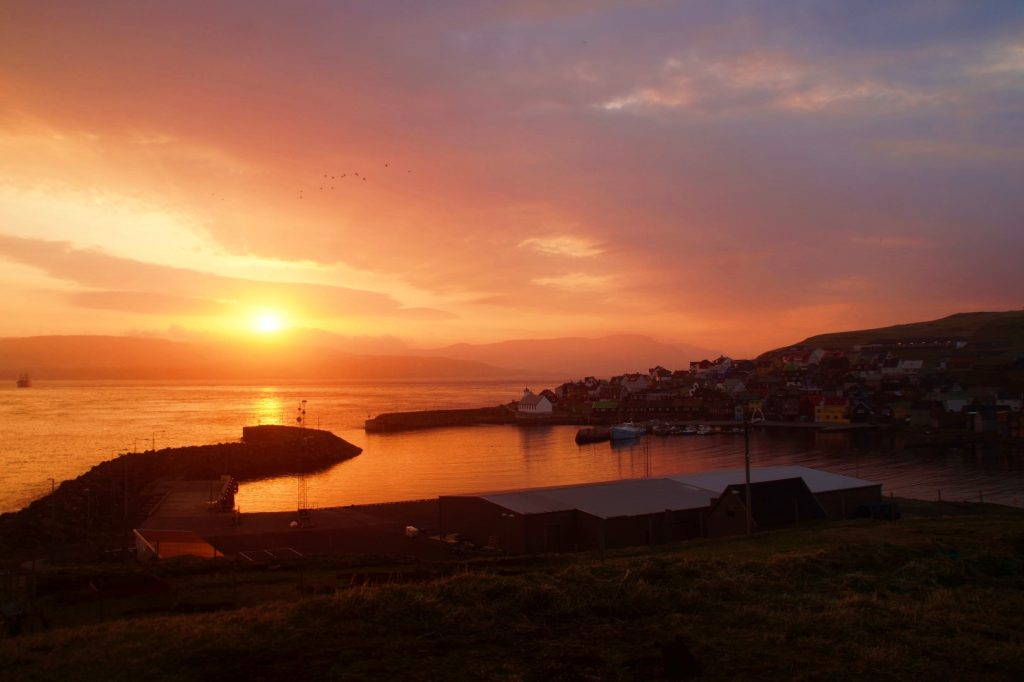
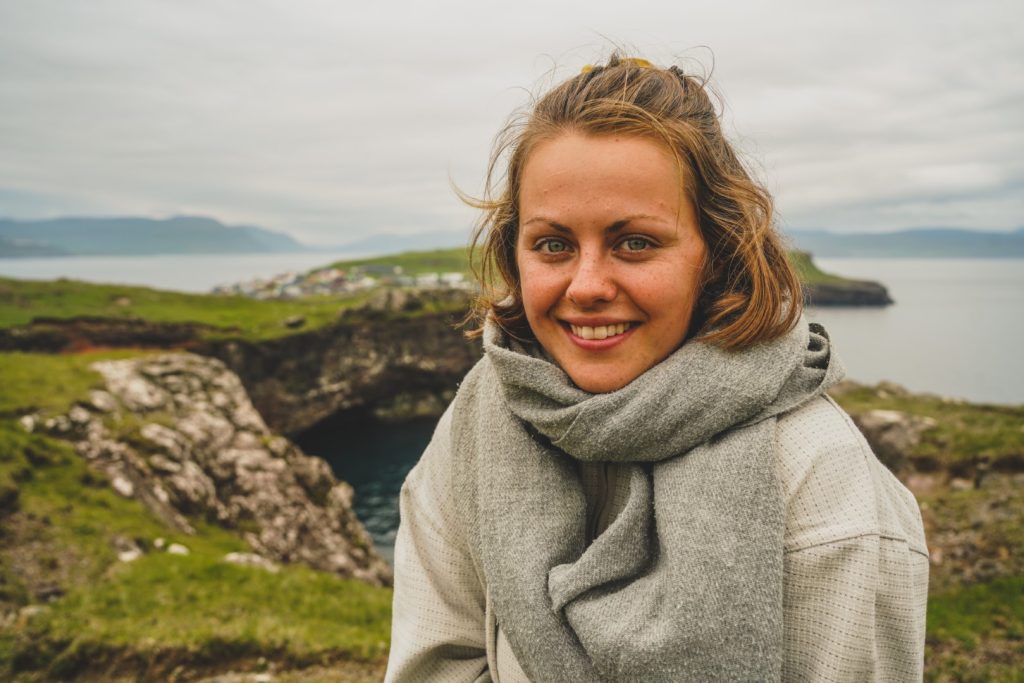
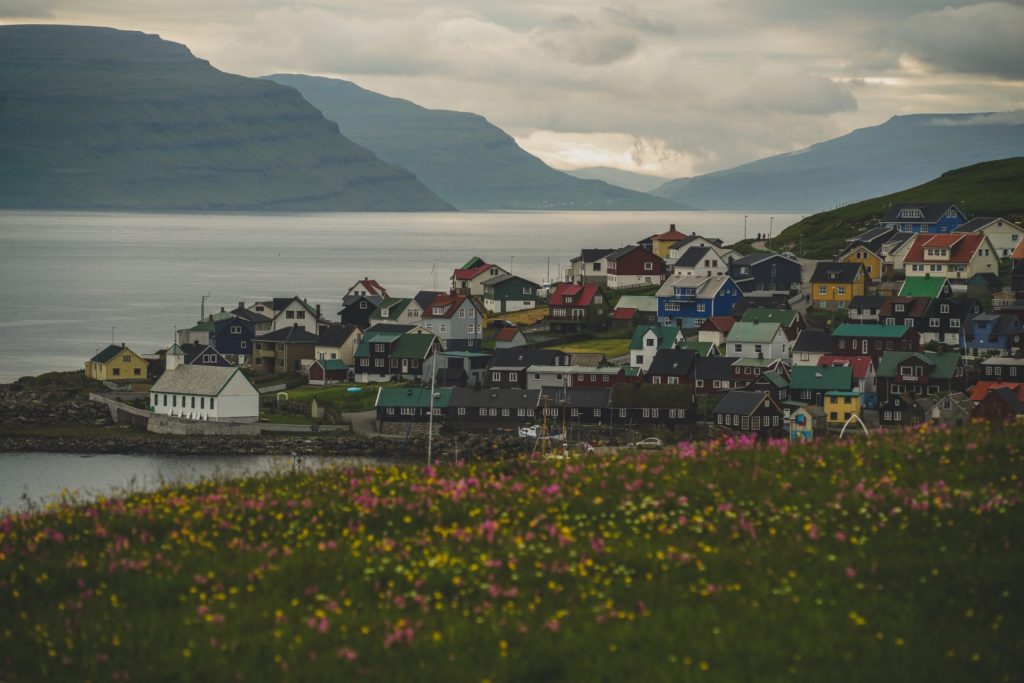
Enjoy beautiful Nólsoy! It’s one of my favourite islands in the country, and I’m sure you’ll fall in love with it too!
Updated 24/06/2023
Leave a Comment
Pingback: Faroe Islands on a budget: How to sleep for free! – Northtrotter on 18/06/2019
Pingback: My June 2019: A month of excavating in Russia – Northtrotter on 18/06/2019
Pingback: My June 2023: Summer in Denmark & the Canadian Rockies – Northtrotter on 18/06/2019
Pingback: My July 2022: The beginning of a summer of travels – Northtrotter on 18/06/2019
Trackback: My Homepage on 18/06/2019
Pingback: My favourite new destinations of 2022 – Northtrotter on 18/06/2019

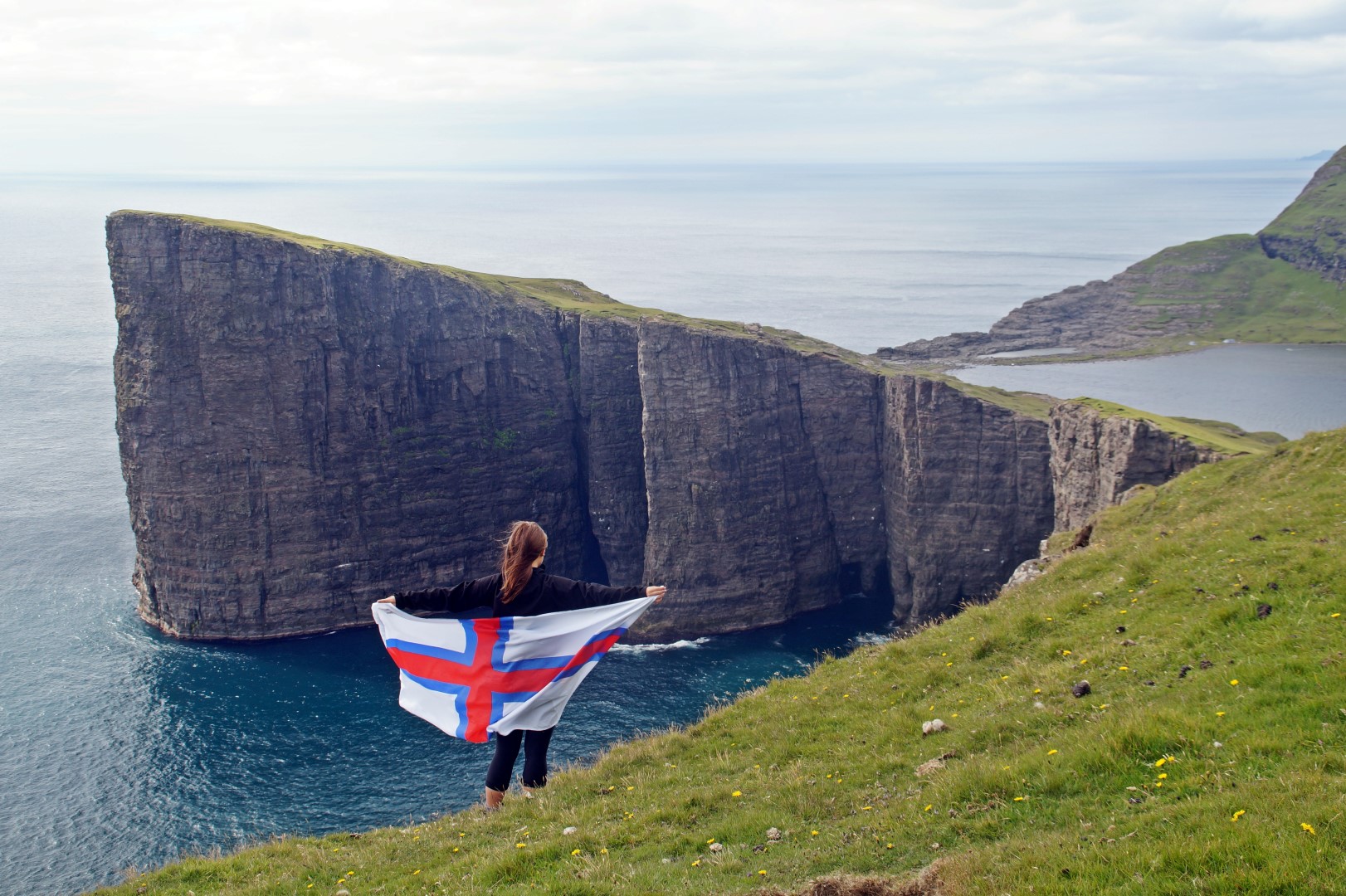
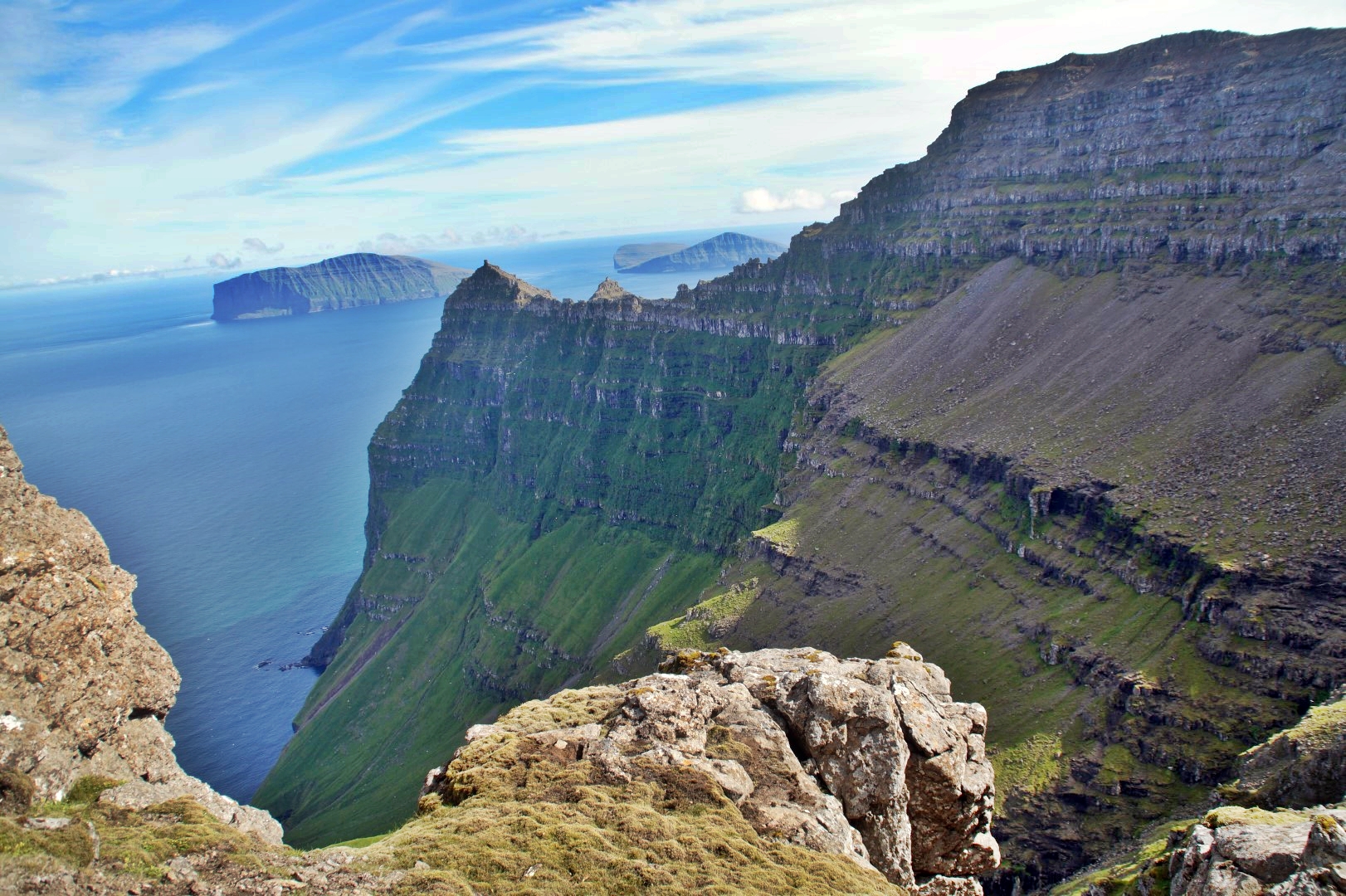
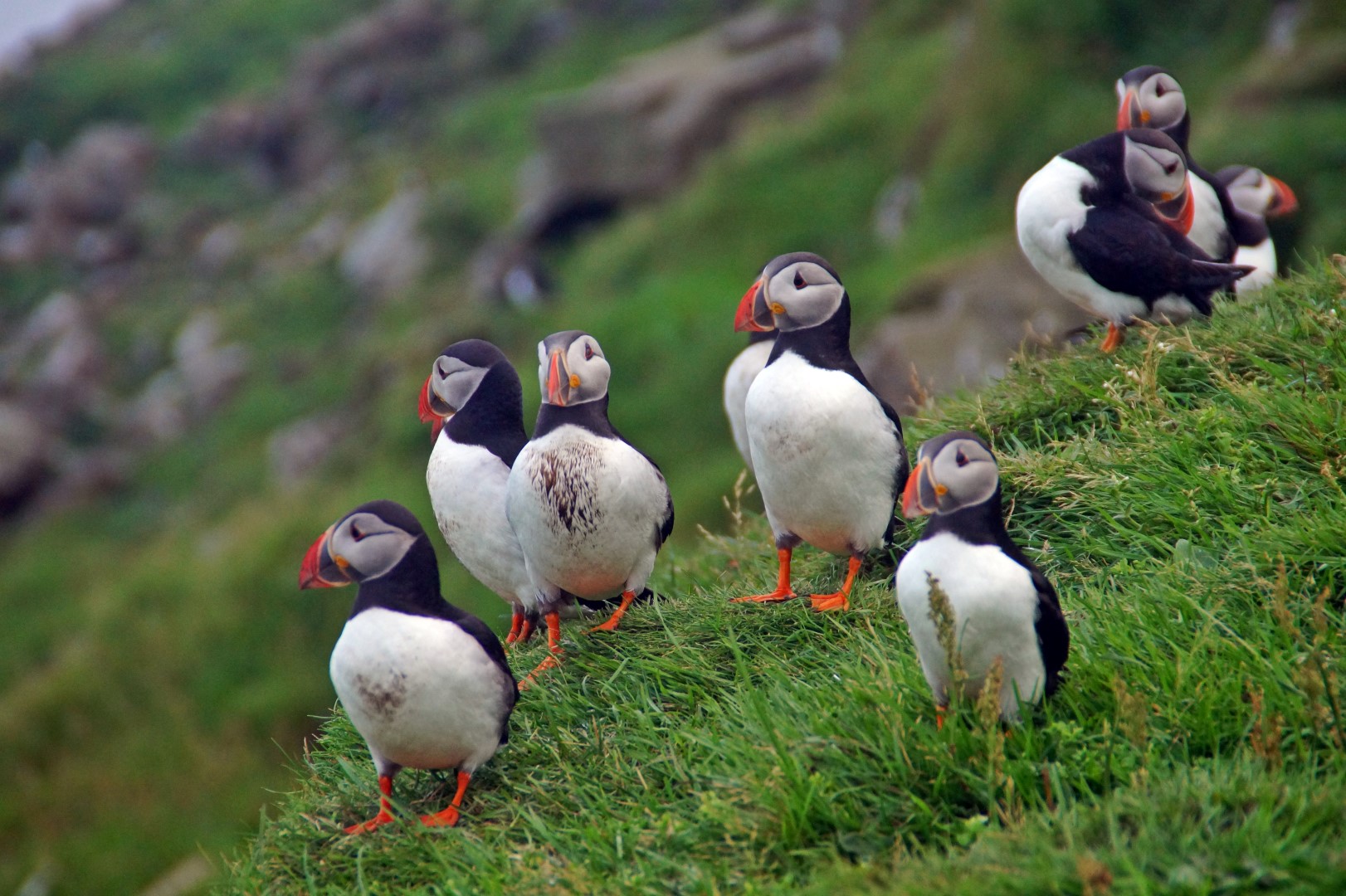

6 COMMENTS